




Atkin Center for Outpatient Rehabilitation provides a comprehensive range of therapy services to adults of all ages to get you back to your lifestyle after an injury, surgery, or an illness. Patients benefit from one-on-one sessions and seeing the same therapist throughout the course of their treatments. Call us at (585) 784-6530 or visit JSLOutpatientRehab.org for more information or a consultation.
am getting stronger with each visit.
therapist is knowledgeable and helpful.
Patient, Outpatient Rehabilitation

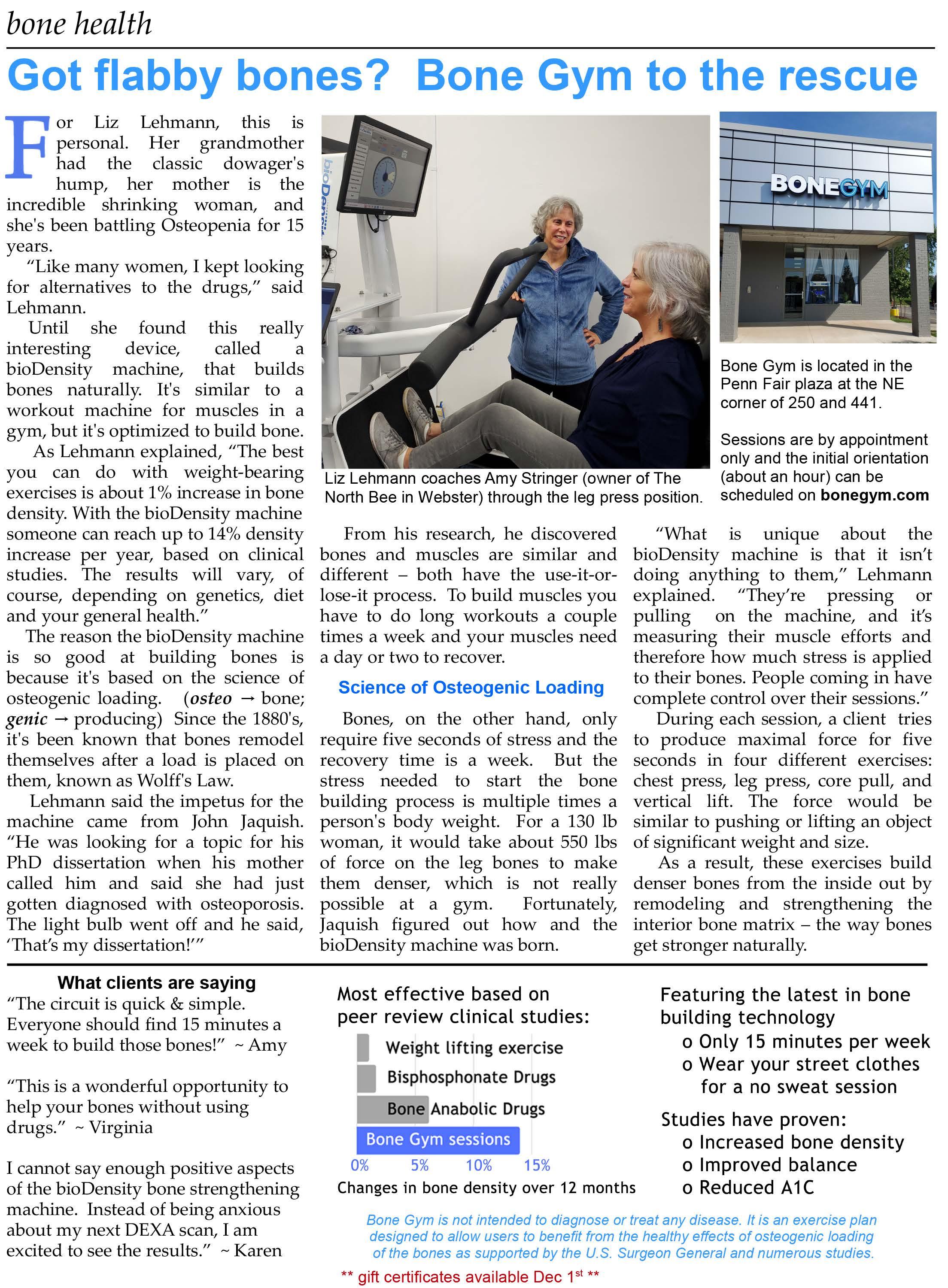
It’s about more than just weight loss. It’s about reducing your risk for serious conditions like heart disease and diabetes — and regaining the stamina, mobility and confidence to take on every day.

Crouse’s bariatric surgery program offers a dedicated team of physicians and providers, as well as psychological and nutritional counseling — all with the expertise to support you every step of the way.


Begin the process from home by viewing our online informational video. Then consult with our bariatric team via telemedicine visits to start your journey. It’s time — and now easier than ever.
Start today at crouse.org/weightloss or call .

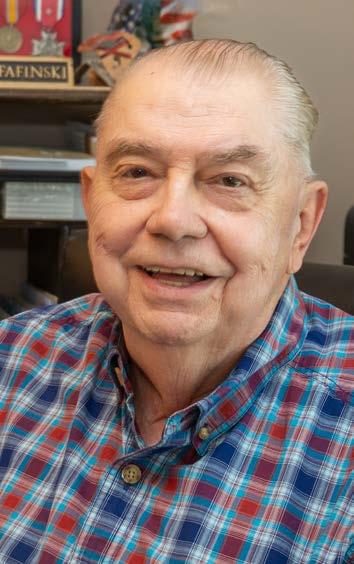

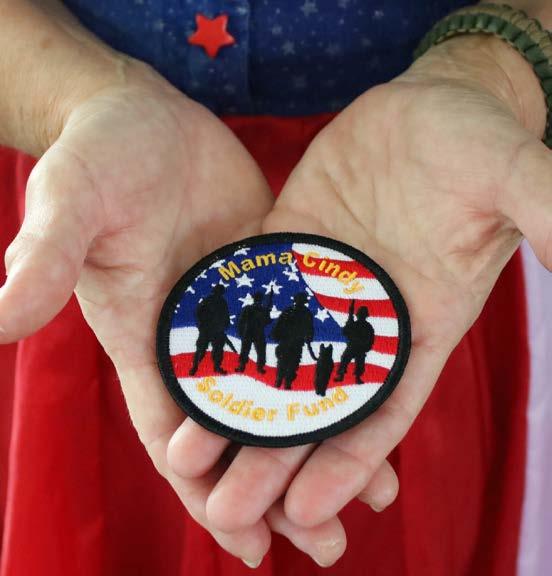





If you think you may have lost track of an old 401(k) retirement account, you aren’t alone. As Americans move from job to job, many leave scraps of their company sponsored 401(k) plans behind, believing they’ll deal with it later, but never do.
In fact, according to a recent study, Americans have left behind around $1.35 trillion in retirement accounts that are connected to previous employers.
To help you look for an old 401(k), here are some suggestions along with some free resources that can help you search.
The first way to look for an old 401(k) account is to contact your former employer’s human resources department. Ask them to check their plan records to see if you ever participated in their 401(k) plan, and if so, how much it’s worth. You’ll need to provide them your Social Security number and the dates you worked for them.
If you need help tracking down your former employer because it may have moved, changed owners or merged with another firm, help is available from the Labor Department (AskEBSA.dol.gov, 866-444-3272) and the Pension Rights Center and Pension Action Center (PensionRights.org/ find-help).
If there was more than $5,000 in your 401(k) account when you left, there’s a good chance that your money is still in your workplace account.
Your former employer should be able to either get you the forms necessary to roll over your retirement money to a different 401(k) or to an IRA, or to give you contact information for any outside financial institution overseeing the plan on your employer’s behalf. By following the appropriate instructions, you’ll be able to move your retirement money
But if your old 401(k) account was under $5,000, your former employer has the option of transferring the money to a default individual retirement account without your consent. Your cash may go into an interest-bearing, federally insured bank account or to your state’s unclaimed property fund.
If this is the case, and your old employer cannot tell you where your 401(k) funds were sent, you’ll need to track it down yourself.
While there’s no federally run national database where you can look for all the retirement accounts that are associated with your name, a good place to start your search is with the Department of Labor’s abandoned plan database at AskEBSA.dol.gov/ AbandonedPlanSearch. And FreeErisa (FreeErisa.BenefitsPro.com), which maintains a rundown of employee benefit plan paperwork.
There’s also the National Registry of Unclaimed Retirement Benefits at UnclaimedRetirementBenefits. com. This site works like a “missed connections” service whereby companies register with the site to help facilitate a reunion between exemployees and their retirement money. But not every company is registered with this site.
To see if your 401(k) money was turned over to the state’s unclaimed property fund, use the National Association of Unclaimed Property Administrators website (Unclaimed. org) to search. Or you can do a multi-state search in 39 states at MissingMoney.com.
Or, if you think you were covered under a traditional pension plan that was disbanded, call the U.S. Pension Guaranty Corp. at 800-326-5678, or use the trusteed plan search tool at PBGC. gov/search-trusteed-plans.
Wagner Dotto
Associate Editor
Steve Yablonski

Deborah J. Sergeant, John Addyman
Melody Burri, Kimberly Blaker, Mike Costanza, John Csiszar
Laurie Haelen
Jim Miller, John Addyman
Christopher Malone
Donna Cordello
Anne Westcott • 585-421-8109
anneIGHsales@gmail.com
Linda Covington • 585-750-7051
Ahme Cruz
Angel Campos-Toro
Cover Photo Rikki Van Camp55 PLUS – A Magazine for Active Adults in Rochester is published six times a year by Local News, Inc. at PO Box 525, Victor, NY 14564, which also publishes In Good Health — Rochester's Healthcare Newspaper.
Subscription: $21 a year; $35 for two years
© 2022 by 55 PLUS – A Magazine for Active Adults in Rochester.
No material may be reproduced in whole or in part from this publication without the express written permission of the publisher.
P.O. Box 525
Victor, NY 14564
Phone: 585-421-8109
Fax: 585-421-8129







Union Tavern: The mostly wood interior shows the place aged gracefully and is warm, especially for those cold winter nights.
To celebrate my personal favorite time of the year, autumn, what a better way to celebrate than taking a bite into comfort food.

That’s right, folks. Break out those “Live, Leaves, Lattes” signs from your favorite kitschy store.
Although tavern food might not be at the top of my list for reviews, as many serve up all too familiar fare, the Union Tavern’s menu boasted a few atypical items catching
my attention.
The tavern, which is right across the street from Sea Breeze, also boasts a significant history dating back to the early 1800s. A brief history is mapped out right on its website.
My curious mind asks: Is this place haunted? According to the staff and Haunted History Trail of New York State, Union Tavern is. It’s very fitting for the start of “spooky season.”
Although the haunted premises wasn’t a huge surprise, the rest of the restaurant’s
aesthetic beauty was. The photos online don’t do the place justice. The mostly wood interior shows the place aged gracefully and is warm, especially for those cold winter nights. It’s also especially clean, including the bathroom.
Another surprise: No televisions. Aside from the music, it’s a perfect place to drop electronic devices, choose a game from the nook beneath the Union Tavern’s staircase (or bring your own), and embark on conversation.
To kick the meal off, aside from a “Tiny Kind” session IPA ($5 for 12 ounce can) from Rochester’s own Three Heads Brewery, the potato kegs ($10) caught my attention, as many unique food items do. Not many places have these enlarged, crispy tater tots stuffed with cheese, chives, and bacon. Shredded cheddar and lime crema dressed the top of these barrels.
It’s a great appetizer and easily sharable with six “kegs” in the basket. Ask for a side of sour cream, if your heart desires, but the crema does the trick. If this doesn’t start a conversation, there’s cause for concern.
General Wow’s cauliflower: The flash-fried cauliflower and herbed rice are coated with a zesty Asian sauce with a noticeable kick.Union Tavern is also friendly to gluten-free, vegetarian, and vegan patrons.
Although the grain bowl ($21) may not be something for gluten-free diets, it’s sure to get the attention of everyone else. Ancient grains, mushrooms, peppers, and zucchini are all mixed together with a flavorful herb puree. The freshness of the grains and veggies are noticeable, but the herbs are prominent.
The heaping serving is also easily shareable, but leftovers will be taken home if dining solo or with someone special. The hearty dish can be heartier by adding chicken, shrimp or steak with a $6 or $7 upcharge.
To not leave out the gluten-free folks, check out the also vegan and vegetarian friendly “General Wow’s cauliflower” ($17). The serving size is similar to that of the grain bowl. After taking one bite, I was standing at attention and saluting the dish.
The flash-fried cauliflower and herbed rice are coated with a zesty Asian sauce
with a noticeable kick. The spiciness isn’t overwhelming, coming from a person who loves spicy food and has a tolerance.
However, it doesn’t kill the dish or your taste buds.
To keep the hearty dishes coming and savoring the tavern’s appeal, here comes the fish and chips ($16). Because Fridays are too limiting to celebrate the United Kingdom staple, the haddock fish fry is offered on Wednesdays as well.
A large, eight to 10 ounce piece of fresh haddock — most of Union Tavern’s fish dishes are cod, per the staff — sits on a bed of thick-cut, slightly crispy tavern fries. The fried haddock has a light, crispy beer-battered coat embracing the bright white fish meat. Dash on some malt vinegar and get generous with the tartar sauce to cover the flavor spectrum. Plus, there’s a side of coleslaw.
Before tip, the meal came to just less than $80.

Aside from a couple fish fries each week,

TOP: Fish and chips is served on Fridays and Wednesdays. A large, 8 to 10 ounce piece of fresh haddock sits on bed of thick-cut, slightly crispy fries.

LEFT: Grain bowl: Ancient grains, mushrooms, peppers, and zucchini are all mixed together with a flavorful herb.

RIGHT:Potato kegs: Enlarged, crispy tater tots stuffed with cheese, chives, and bacon. Shredded cheddar and lime crema dressed the top of these barrels; puree.
Union Tavern has “Wine Wednesdays,” “Beers with Friends Thursdays,” live music, paranormal investigations, murder mystery dinner parties, psychic and tarot card readings, and much more.
Check out its website for more information and dates.
And, if you’re planning to eat dinner, especially toward or on the weekend, call to make reservations.
According to their incredibly personable bartender and server, Kym, it does get busy.
Culver Road,
NY

Sunday: noon – 8 p.m.
Monday: closed
Tuesday – Thursday: noon – 8 p.m. Friday and Saturday: noon – 10 p.m.
The start of 2022 found both stock and bond markets holding their value well after a strong 2021. As events of 2022 began to unfold, volatility began to emerge and threaten the continued upward march of the equity markets. Events like the Russia-Ukraine war, continued supply chain issues, and, of course, inflation, made interest rate increases inevitable for the foreseeable future.
The reality is we all knew the good times for stocks could not last forever. But many investors have been surprised by the severity of declines in the less risky portion of their portfolio: bonds. How could bonds be down double digits by the end of August when they are supposed to provide a haven for portfolios? More importantly, what can help mitigate the risk in bonds and help your portfolio maintain value in such challenging times?
After dropping the benchmark federal funds rate to a rock-bottom range of 0%–0.25% early in the pandemic, the Federal Open Market Committee began raising the rate toward more typical historical levels in response to high inflation. As inflation has remained stubbornly elevated, the Fed has accelerated these moves and has done, as of this writing, three .75% moves within the past few months. Additionally, the Fed has stated it will continue to be more aggressive as needed, even if it causes pain to investors and businesses alike, as the cost of borrowing rises while capital declines.
When interest rates rise, the value of existing bonds typically falls because investors would prefer to buy new bonds with higher yields. In a rising rate environment, investors may be hesitant to tie up funds for a long period, so bonds with longer maturity dates are generally more sensitive to
rate changes than shorter-dated bonds.
Thus, one way to address interestrate sensitivity in your portfolio is to hold short- and medium-term bonds. However, keep in mind that although these bonds may be less sensitive to rate changes, they generally will offer a lower yield than longer-term bonds.

A more specific measure of interestrate sensitivity is called duration. A bond's duration is derived from a complex calculation that includes the maturity date, the present value of principal and interest to be received in the future, and other factors. Your investment professional can provide you with information about the duration of your bond investments, as it is not an easy thing to calculate on your own.
When a bond is held to maturity, the bond owner receives the face value and interest unless the issuer defaults. However, bonds redeemed prior to maturity may be worth more or less than their original value. Thus, rising interest rates should not affect the return on a bond you hold to maturity but may affect the price of a bond you want to sell on the secondary market before it reaches maturity.
Owning a diversified mix of bond types and maturities can help

reduce the level of risk in the fixedincome portion of your portfolio. One structured way to take this risk management approach is to construct a bond ladder, a portfolio of bonds with maturities that are spaced at regular intervals over a certain number of years. For example, a five-year ladder might have 20% of the bonds mature each year.
Bond ladders may vary in size and structure and could include different types of bonds depending on an investor's time horizon, risk tolerance and goals. As bonds in the lowest rung of the ladder mature, the funds often are reinvested at the long end of the ladder. By doing so, investors may be able to increase their cash flow by capturing higher yields on new issues. A ladder also might be part of a withdrawal strategy in which the returned principal from maturing bonds provides retirement income.
Bond funds—mutual funds and ETFs composed mostly of bonds and other debt instruments—are subject to the same inflation, interest rate and credit risks associated with their underlying bonds. Thus, falling bond prices due to rising rates can adversely affect a bond fund's value. Because longer-term bonds are generally more
sensitive to rising rates, funds that hold short- or medium-term bonds may be more stable as rates increase. However, one benefit to a bond fund is professional management, which can be very helpful in navigating through the changing rate environments.

Whether you invest in individual bonds or a bond fund/ETF, there is a silver lining to this bond “repricing” due to interest rate changes. Whereas for many years, bonds yields lingered at 2-3%, now high-quality bonds are available with much higher coupon rates. Although not yet matching inflation, 4-5% bonds are now being issued, so the fixed income portion of your portfolio is going to give you a raise! As a matter of fact, even dividend-paying stocks are on sale now, and with the market’s decline you may be able to restructure your portfolio to provide a much higher income stream—and a chance at capital appreciation as well.
Another silver lining to be considered is the availability of tax losses in bonds or bond funds you already own. By selling the bond or fund in a taxable account, you can remain in cash for 31 days (money markets are now around 2%) and buy new bonds or funds with more attractive coupon rates. The loss can be used against any gains this year or carried forward to help mitigate taxes in subsequent years. An adviser can help you evaluate the benefits of this and ensure it is done correctly to avoid the wash sale rules, which can void a loss if one is not careful.
It is important to remember that all challenges present opportunities, and this includes market downturns. A proactive approach to achieving lasting financial success means evaluating your plan on at least an annual basis and ensuring that your investments match your needs. Over the long term, this will smooth out the inevitable volatility and hopefully enable you to enjoy the things that matter most to you.
Haelen


585-4190670, ext. 41970






at lhaelen@

After more than 65 years as a barber, Rocco “Rocky” Ceravolo still has a good reason to come to work.

“I got great customers,” the 85-year-old Fairport resident says. “They like me, I like them.”

And those customers keep coming back for haircuts, and a chance to catch up with the popular barber on local news, family events and sports.
“We don’t talk religion or politics,” Ceravolo says.
After finishing high school in
Canandaigua Academy in 1955, Ceravolo enrolled in a barber school in Buffalo, intent on following his late brother Joseph into the profession.
“I didn’t have the money for college,” he says.
Ceravolo apprenticed at the Hotel Rochester, which once stood at the intersection of West Main Street and Plymouth Avenue in the city’s downtown. After completing the oneand-a-half-year program, Ceravolo married Mary Rinaldo, a Fairport native, and began barbering in a shop
on North Main Street in the village of Fairport.
“When I started, haircuts were $1.25,” he says.
The late Ron Jensen learned of Ceravolo’s skills and offered him a chance to join the R & J Barber Shop as its third partner in 1972. The “R & J” stand for the first names of Jensen and the late Jim Apara, the business’s other founding partner. Ceravolo signed up.
Ceravolo now works alongside Jensen’s son Tim, the other partner in the business. But for 11 weeks R & J
RIGHT: Rocky Ceravolo has been cutting hair for five generations of Fairport's Martens family. From left are John Alexander Martens, Rocky Ceravolo, James Martens, John Michael Martens, Alex Martens (sitting in a chair) and his son Oliver Martens (sitting on his lap).
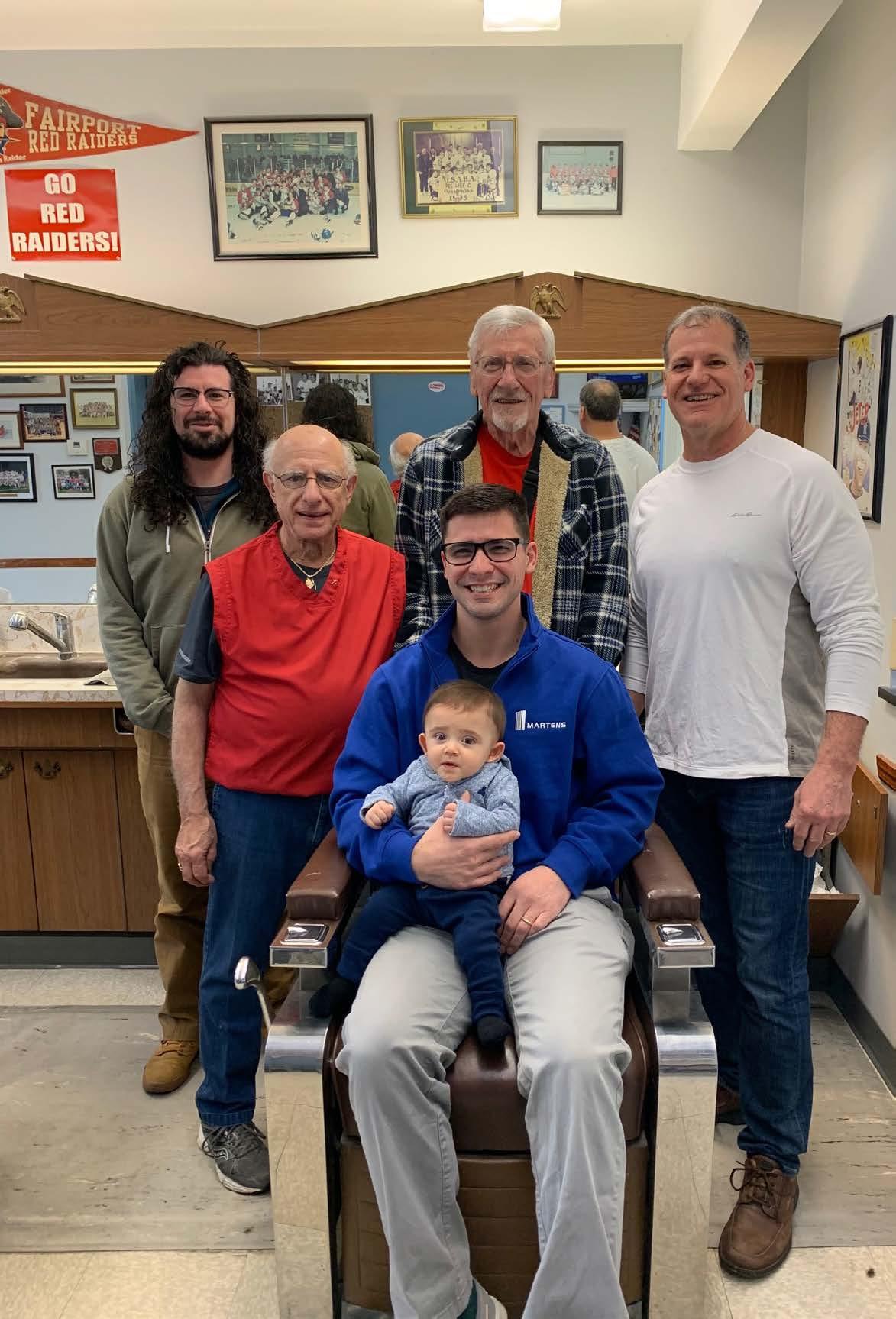
was closed in 2020 due to COVID-19, he’s continued to serve his customers at the same corner chair since 1972.
“He’s a legend,” says Marshall Zemans, who has worked at R & J one day a week since 2019. “He’s old school.”
So, in many ways, it is the place where Ceravolo takes care of his many customers.
A glass cabinet in R & J’s small waiting area is filled with barbershop memorabilia, including an old-style straight razor, hand-operated hair clippers, a massage machine and an antique barbershop sign. In one corner of it stands an aging plaque that reads “Member Monroe County Barbers Association Inc.” One wall of the shop is filled with posters from Fairport Canal Days, the town’s annual summer celebration, and a second has photos of pro baseball players.
“I’ve been a Yankee fan since I was a kid,” Ceravolo says.
He was also a Green Bay Packers fan, but switched to the Buffalo Bills after the death of Vince Lombardi, the Packers’ former coach.
A third wall of the shop bears photos of Fairport High School teams. From the 1960s to the 1980 s, many of the players came to R & J for their haircuts.
“Rocky and his co-workers, they catered to the local athletes and their families,” says 61-year-old John Martens, who once played football for Fairport High School. “They were great supporters of the Fairport sports teams.”
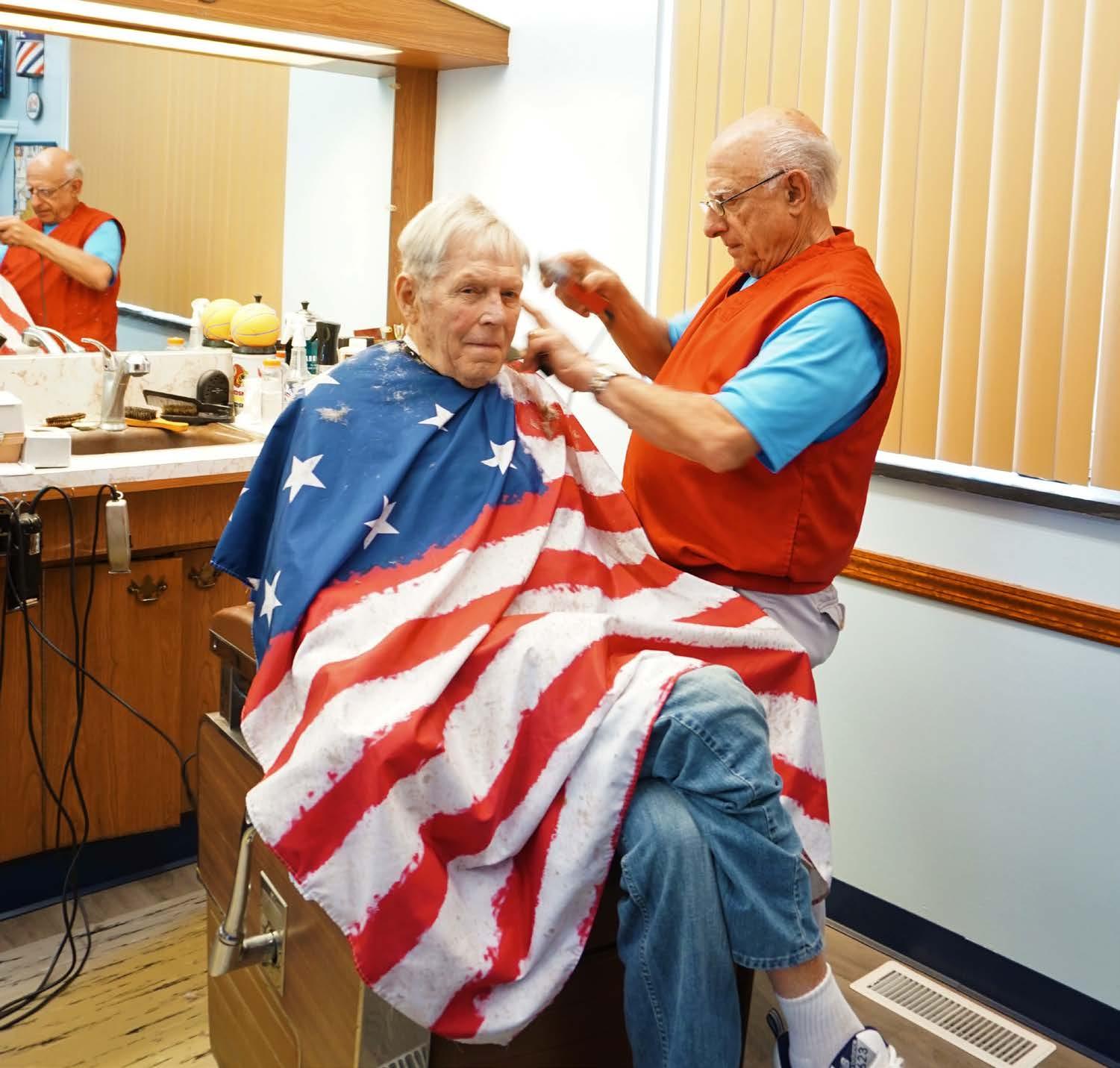
Martens has continued to come to Ceravolo down through the years for haircuts—and conversation.
“The atmosphere at the barbershop is very, very home town-feeling,” says the Fairport resident. “It’s a very enjoyable experience to go there, catch up on local news, catch up on each other’s families.”
Altogether, five generations of Martens’ family have come to Ceravolo for their haircuts.
“Rocky has become a very, very close family friend,” Martens says. “We’ve become quite close to him and his wife Mary.”
Ceravolo is so dedicated to his customers that he’ll even head to their homes on occasion to cut their hair — three are over 100 years of age. He even cuts the hair of Rev. Peter Clifford, the pastor of St. John of Rochester, the Fairport church that he and his wife Mary attend every Sunday.
Though he’s in the shop only four days a week now, Ceravolo has no plans to retire.
“I’ve been very lucky,” he says. “After 65 years, my arms and legs are still good.”
The phone rang, and Ceravolo picked it up.
“R & J, Rocky speaking.”
TOP: Barber Rocky Ceravolo in action — as he cuts the hair of, Jim Enright, an 87-year-old Perinton resident who has been a client since 1970.Many people reach their peak net worth right when they retire. This also happens to coincide with the feeling that it’s time to spend some of that net worth after working so hard to accumulate it over the years. However, without proper financial planning and budgeting, this can sometimes lead to a disastrous combination.

If retirees overspend immediately after they stop working, they may find themselves coming up short in their later years for even the most basic needs. To help avoid that situation, check out this list of purchases that retirees almost always regret, and make sure they fit into your long-term budget before you make a financial misstep.

1 2Those who are generous in mind and spirit might see retirement as the time to spend on nice gifts for friends and former work colleagues. While tokens of appreciation are always in good taste, it’s important to balance kindness toward others with the preservation of your financial wellbeing. If you retire with $1 million, for example, you might feel like you can afford to buy cruises or cars for special people in your life. But at tens of thousands of dollars per shot, you’ll find that $1 million won’t last you very long at all, especially if you have 30 or more years of retirement ahead of you. Feel free to be generous, but keep your giftgiving within reason.
If you’ve grown accustomed to upsizing your house throughout your life, you might feel like when you retire, at the peak of your net worth, it’s time to splurge and get the biggest house of your life. But generally speaking, that is actually the worst time to do that. If you have kids, they have most likely left the house, leaving you and perhaps your spouse alone to both occupy and maintain a large home. In other words, except for entertaining purposes, you likely won’t ever use most of your giant home. In the meantime, all of your other expenses will increase, from your property taxes to your heating bills to your maintenance costs. At a time when you have shut off the main source of your income, dramatically increasing your expenses is the last thing you want to do.

Many older Americans have travel on their minds when they finally retire, and that’s a great way to occupy your time. However, if you blow a big chunk of money on a round-the-world cruise for two the moment you retire, you could be crippling your future financial well-being. Not only will that money immediately go out the window, but you’ll also be losing up to 30 years or even more of investment returns on that cash. While there’s nothing wrong with traveling after you retire, try not to get overexcited and blow five or 10 years of your retirement budget in a single outing.
For many retirees, the urge to give money to children is even stronger than the desire to buy gifts for friends and colleagues. In some cases, providing early gifts to children can be a valuable part of an estate-planning strategy. But if you intend to fully support your adult children or shower them with boatloads of cash, you’re likely to regret it. Not only do you run the risk of denying them self-sufficiency, you may find that you’ll need that money back in your twilight years — when it’s no longer likely to be in their possession.

Expensive cars fall into the “I earned it so I’m going to spend it” category when it comes to retirement. While it’s completely understandable to want a comfortable car when you retire, you’ll have to balance the costs with your budget. Remember that an expensive car is an ongoing expense, not a one-time purchase. Luxury cars tend to have higher maintenance costs, higher insurance premiums, and higher fuel costs, as many require premium gasoline. Plus, luxury cars tend to depreciate rapidly. Be sure to factor in all of these costs when deciding if you can truly afford an expensive car without damaging your long-term standard of living.


Insurance is important to have as a retiree. But overspending on insurance you don’t need is wasteful and can be an unnecessary drain on your nest egg. Life insurance is a great example. Typically, working adults take out life insurance so that loved ones are provided for in the event that a family breadwinner dies prematurely. But by the time you retire, your kids have likely completed their education and are out of the house, and your home mortgage is likely nearly or fully paid off. While you might want to keep a small policy to help your spouse in case you die, you won’t likely need the $1 million-plus policies often taken out by younger


One of the things that people look forward to most when thinking about retirement is additional free time. However, if you’re financially undisciplined, your free time could end up costing you. If you’re prone to late-night TV solicitations for “only available on TV” products, or if you spend a lot of time on the computer visiting shopping sites like Amazon, you may find that you’re spending a lot more than you used to when you were working and your free time was occupied. Typically, items that people buy when they are bored tend to be nonessential and regrettable. Keep an eye on your spending after you retire, and realize that you don’t have the same steady income that you used to have while working.

A vacation home is a fun way to spend time with friends and family, but it’s often a purchase that retirees regret. For starters, you’ll be dramatically increasing your expenses at a time when you’re turning off your main source of income. In addition to your mortgage, you’ll have to add property taxes and maintenance costs to your retirement budget. Second homes also typically have more unfavorable tax consequences. Over time, you may find that you don’t even use your vacation home as often as you thought, as you now have the freedom to travel to more places in the world.

Story originally published at www. gobankingrates.com. Reprinted with permission.
enjoying a social, active lifestyle with support available

needed.
a tour of our beautiful, newly renovated community.


 By Deborah Jeanne Sergeant
By Deborah Jeanne Sergeant
When to begin drawing on Social Security may seem like an easy question to answer. Those who were born in 1960 or later may begin as soon as they turn 62.
However, they would lose $300 per month for a $1,000 payment compared with a peer who waited until age 67. That equals $3,600 a year or $46,800 total between ages 62 and 75.
So why would anyone start drawing on it early?
“Some people may decide to take Social Security earlier because they are worried that they may not live very long,” said Diana Apostolova, investment consultant at Rochester Investments. “If people don’t live long enough, they’ll collect less money versus if they had started earlier. The money that they forgo goes back to the government rather than their family.”
Retirees with serious health conditions or substantial family medical history may want to weight their longevity compared with the lower monthly payments.
Apostolova added that some people may think that Social Security itself will not last very long.

“Alternatively, people may be concerned about the Social Security running out of money and not be able to collect their full benefits if they wait,” she said. “Generally, changes in laws impact future recipients and grandfather current recipients.”
Jeff Feldman, Ph.D. and certified financial planner with Rochester Financial Services in Pittsford, said that typically, waiting until 67 or even 70 is a better idea for most people.
“We talk about breakeven points,” Feldman said. “A lot of people say 80 or 85 might be break even, but it’s more about interest rate breakeven point. If you take it at 62 and that allows you to keep investments invested instead of drawing on them, if you take a total return of 5% to 6%, it would pay to take it early. You’ll generate more income and make up more of the difference on what you’re losing by taking it early.”
But he added that theory depends upon the retiree’s tolerance for risk, as the market does not always offer consistent returns. Delaying means a guaranteed return on the money that does not rely upon a volatile market. That is why Feldman looks at the client’s entire financial situation.
Marital status also matters when making the decision of when to begin receiving Social Security.
“If you’re married and you’re the higher wage earner, by delaying until 70, your spouse will benefit by getting the higher amount,” Feldman said. “It’s like a life insurance policy. You’re ensuring your spouse will get a higher payout. It’s not a one-size-fits-all. Each person will be different but the general concept is it doesn’t always pay to wait but is beneficial for many people.”
In most situations, Phillip Provenzano, insurance agent and financial adviser with The Financial Guys Insurance Agency in Rochester, advises against drawing on Social Security early because of the lower payout.

“But like everything else, there are a few exceptions,” Provenzano said. “If your health situation or family history indicates a lower life expectancy, that could be something to consider, as are disabled kids that may become eligible for benefits. When a disabled child is able to collect on your Social Security, that also factors into who, what, where, when how. Every situation is different.”
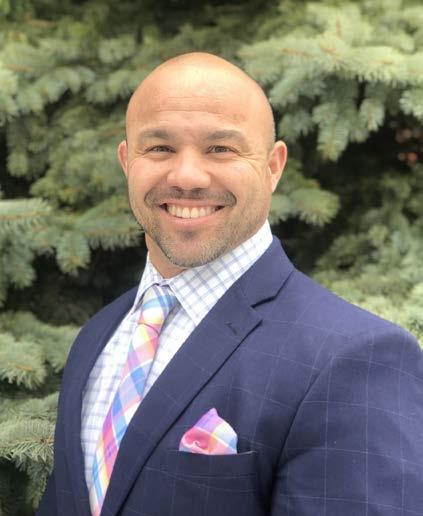








Considering buying life insurance or additional life insurance at age 60 or older?
Although this seems like a simple question, many factors play into the answer, including your health.
The applicant’s health determines in part the cost of the policy.
“Buying a new life insurance policy at age 60 or older can be a lot more expensive than buying it at a younger age,” said Diana Apostolova, investment consultant with Rochester Investments.

According to valuepenguin.com, “the average life insurance quote only increases by 6% between ages 25 and 30, but it jumps much higher between ages 60 and 65—an average increase of 86%, or $275 per month.”
This is because the likelihood of a payout is much higher the older a policyholder becomes.
“Some people may not be able to qualify for a plan for a medical reason. So, considering a new life insurance policy should involve a review of all other finances to determine the best plan of action.”
Typically, companies use metrics such as the applicant’s age, weight, tobacco use status and employment. These all affect the applicant’s risk of death. While the cost of the premiums may outweigh the merits of holding a policy, “life insurance can be a good idea for people that aren’t able to selfinsure,” Apostolova said.
For most people, the reason for obtaining life insurance is no longer present.
Jeff Feldman, Ph.D. and certified financial planner with Rochester Financial Services in Pittsford, views life insurance as protection for the policyholder’s income.
“Depending on what your income is, if you’re retired, it doesn’t make sense to have it because you have assets and you don’t have an earned income stream,” he said.
Most people 60-plus no longer have young dependents living at home. People who still support children would have a difficult time staying financially viable if the other wage earner in the home dies.
Feldman also pointed out that since most people in retirement have Social Security income as one of their income streams, life insurance is not as important.
“It used to be life insurance would protect against estate taxes,” Feldman said. “Now it's at $12 million per person and $24 million per couple, life insurance isn't a concern for many people,” he added, referring to the maximum allowed estate or gift exempt from tax.
In regard to whole life policies, Feldman looks at the rate of return. For term policies with a locked-in rate, “it usually makes sense to keep paying it,” he said.
Many people view purchasing a life insurance policy at 60 as a means to safeguard their loved ones against final expenses. Burial and funeral cost an average of $7,360, according to the National Funeral Directors Association. Phillip Provenzano, insurance agent and financial adviser with The Financial Guys Insurance Agency in Rochester, would rather see clients who are 60-plus invest in funds instead of buy life insurance for that reason, especially considering the cost of premiums.
“Oftentimes, an adviser will convince the senior that they need this,” he said. “The adviser is the only one who benefits, as the adviser gets a commission. In five years, they’ll outpay what they’ll get in death benefits. They’d be better off putting the money into an IRA and make money on it.”
Pre-paying burial and funeral expenses can also ensure that the family feels no financial burden and it also safeguards against inflation. As with any financial matter, individual scenarios vary widely, so he encourages people to sit down with a trusted financial adviser to look at the options and make educated decisions.
“With a proper plan, a person can determine if life insurance is something that they need,” Provenzano said. “Now a person may not need life insurance but may want it. The rationale for this could be passing on a legacy to a family member or members, estate planning purposes, and so on. There are numerous reasons why people do and do not need life insurance. A proper financial plan can help determine that.”
He warns against the life insurance policies advertised on television as he said that these often have hidden provisions such as reduced benefits for the family if the policyholder dies within two years.
“It’s a matter of starting the planning sooner than later,” Provenzano said. “You need to plan no matter what. If you don’t have much money, you still need to plan as I can help you qualify for benefits you may not be aware of. Whether you have assets or don’t have assets, planning is always a good thing to do as there’s always something to learn. Just go to someone.”







Rochester Knitting Guild holds first in-person meeting after the pandemic — 90 members showed up to knit, socialize and have a good time
By John AddymanYou’re invited to go to a meeting of knitters. Knitters, you know, people who go walk around with bags of needles and yarn and do ”knit one, purl two,” stuff like that.
So you’d expect that the meeting of all those little old ladies would be as active as watching snow build up on your driveway. Quiet. Boring. Reserved. Unexciting.
And you’d be wrong. Dead wrong.
When the Rochester Knitting Guild welcomed 90-some members in mid-September, there was laughter, joy and smiles everywhere. An upbeat spirit and friends getting together to do something they love — knitting.

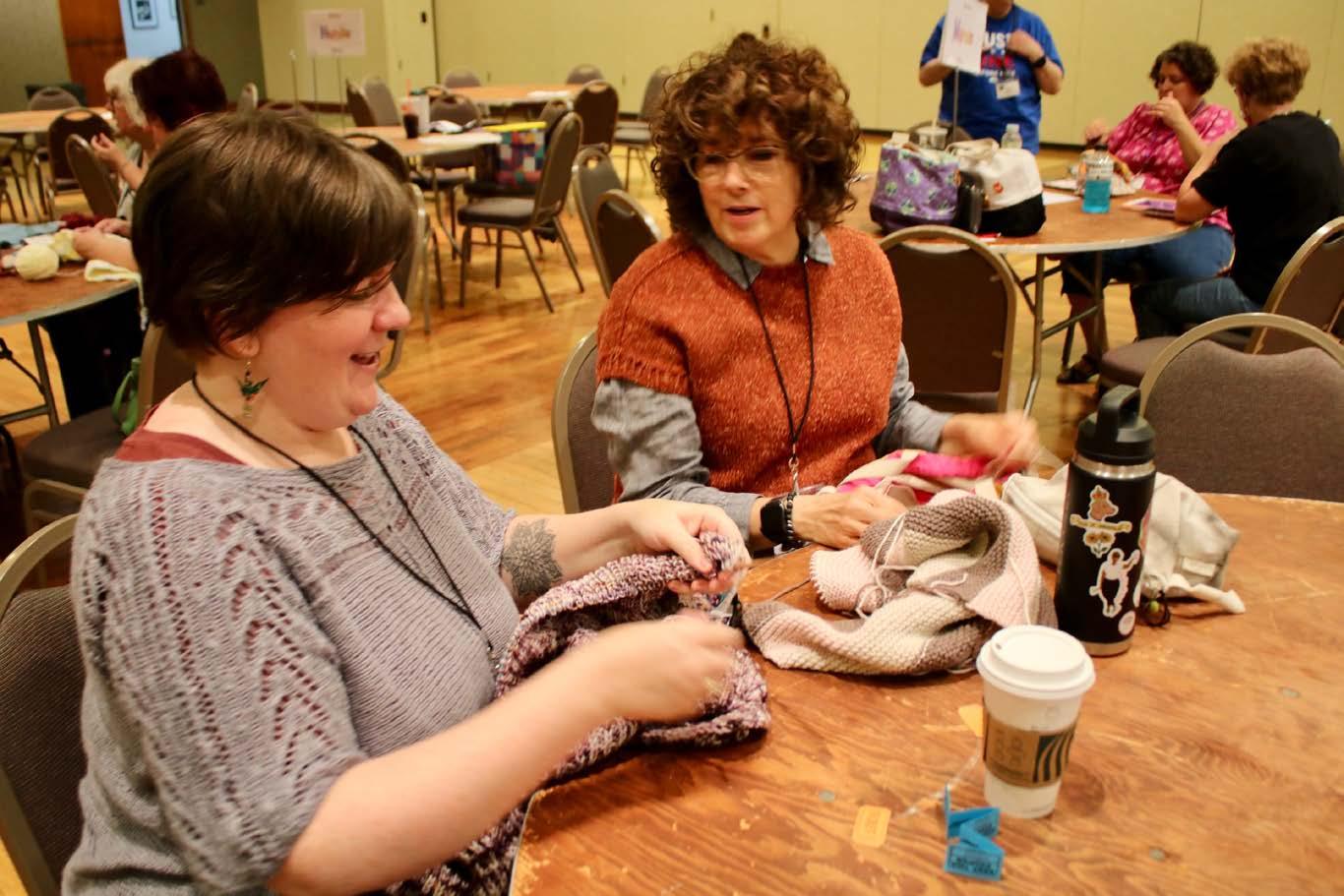
There were prizes, a raffle and two kinds of cake. And a lot of applause.
They have all kinds of activities planned. They take retreats in March. A woman who sat at the “Help Desk” table, Debby Abrahams of Brighton, was at the meeting to answer thorny questions and show knitters how to back up and get something straight again. Her advice came with goodnatured encouragement borne from years spent with her needles.
“No one is born knowing how to knit,” she told the audience sagely. “There are no knitting police. It’s not a mistake [in your project], it’s a styling difference.”
Relax, have a sip of wine, back up and start again.
She and others there helped dispel some folk myths.
First, knitting really is for everyone. Old. Young. Male. Female. North Americans. Indonesians. Latvians. Football players. Meryl Streep. Everybody.
Second, as Abrahams would tell you in her friendly manner, it takes a little bit of time to learn to knit. Not a long time. Not days or even a lot of hours. With a little help, you can get right to it.

Third, knitting is social, not for recluses. You knit for family. For friends.
As knitter Pat Butterfield explained, “When you run out of people to knit for, you knit for the community. Your hats and sweaters go to homeless shelters. Your afghans and blankets go the nursing homes and hospices. Your scarves go to kids who tuck them in close in the winter. They’ll wear your mittens, too.”
And based on the September meeting, knitters love to share what they’re doing with other knitters.
LEFT: Erin Brown from Palmyra and Dawn Verdugo of Fairport do a little social knitting. Brown is working on a baby blanket for granddaughter number 5.
BELOW: Debby Abrahams of Brighton mans the "Help Desk" at September's meeting of the Rochester Knitting Guild. She's there to unravel and solve knitting problems for members and offered sage advice.
Margaret Mullen is the president of the Rochester Knitting Guild. She’s an upbeat drum-beater for knitting as a life hobby, inheriting the leadership of the post-pandemic guild from fabled local knitter Tina Turner.
Mullen describes Turner as “the type of person that, you know how some people’s essence is giving, and not wanting anything in return? She has this amazing skill. She’s been knitting since she was knee-high to a grasshopper. She offers herself to you. Yes, she’s a businesswoman; yes, she owns her own yarn shop; yes, she runs festivals. But if you have knitting issues, she’s your girl.
“You want to have fun in your knitting but it’s an issue when you have a mistake,” Mullen said. “Tina will take that mistake and fix it.”
Mullen speaks from experience — after making a pair of mittens and forgetting the thumb hole.
“Tina steeked [cut] it open and got it back, with love and with concern and with an amazing essence, that’s what she did,” Mullen said.
September’s meeting of the guild was a worry to Mullen. The pandemic had isolated knitters who yearned for the camaraderie. An effort to do some Zoom meetings and classes didn’t go over well. And many area yarn shops had closed their doors.
This meeting started off the 35th year the guild has been active and it was important for it to be a success.
The meeting room at the family center at Temple B’rith Kodesh in Brighton was set up for 120 people. Board members and officers were parceled out to 15 tables, so the membership could connect directly to the folks running the guild. Folks sat down, out came the knitting bags and yarn and needles and things got social and friendly immediately.
Mullen is fairly new to knitting, starting in 2018 after she retired. She has a bachelor’s degree in business and a master’s in social work. She also had a sidelight professional career as a jazz singer with her own Maggie Mullen Jazz Quartet. She has recorded
with the Rochester Metropolitan Jazz Orchestra. Try “Maggie Mullen and jazz” on Google to hear her.
She got a lot of jazz gigs because she studied the basics and was a tireless chart-writer.
“I went to school and I did a whole jazz series — how to make charts, books, for each instrument. I was an easy musician to call — we didn’t have to rehearse. They had the music right there in front of them [which she showed up with],” she said. “That’s why I got a lot of work, and I have a halfway decent voice.”
She taught and she performed.
Freshly retired, she discovered knitting was something she wanted in her life. The artistry in her loves the colors and tactile joys of handling yarn, and the precision of the patterns.



“There was a program at the Brighton Library, ‘Learn How to Knit,’ and I said, ‘Oh yes, I am going to learn to knit.’ I’m a musician. Most of my art has been through my music, it was never a tactile thing,” she said. “I went to the class and the teacher said, ‘You take your needle and you go like this and you go around like that…and look
at this!” She was knitting.
Now speaking at a coffee shop in Pittsford, she brings items out of her bag: gloves.
“I just had to do show-and-tell.” she confessed. “What do you think about this for a beginner knitter? Can you even believe that?
“This yarn feels amazing going through your fingers. You can make beautiful things with it. I started there and I just kept going. I went to my first Rochester Knitting Guild meeting and the woman who taught me, Betsy Liano, took me there.”

Mullen said there are a lot of ways to start knitting with confidence. Many people have family members who are knitters. A trip to Aunt Millie’s house on Thanksgiving could lead to a first lesson in knitting.
“You can pay money and take classes with professional knitters here in town. Or you can go to the library programs,” she suggested.
FROM LEFT TO RIGHT:Margaret Mullen, the president of Rochester Knitting Guild, does a quick show-and-tell of some of her work. She started knitting after retiring four years ago, her artist's sensibilities drawn to knitting by the colors and feel of the yarns; Ron Tyler of Honeoye Falls was one of two guys who brought their knitting to the Rochester Knitting Guild meeting in September. He has been knitting since he was a kid and now hand-spins his own yarn on a spinning wheel. He was working on a basic shawl that night; Peggylee Naas of Bergen is just starting her next project, a sweater, at the neck — thus, the circle.
Once you get started, if you run into trouble, “many times, there’s somebody there who can get you out of mistake trouble or teach you what you want to learn, like Marcia Weinert in Webster. She takes people who don’t know a thing about knitting, so does Tina Turner. They’ll say, ‘You don’t know a thing about knitting? Come, and I will teach you. This is how you do it,’” she added.
The outcome is the product.
“It’s what you make for yourself,” Mullen said, pulling more knitted items out of her bag. “You gift this stuff. You make it for yourself. Who wouldn’t want to wear this hat? (And she holds it up).
“Some of the knitters in the guild make hats, mittens, sweaters and coats. At Christmas, they put them on a table and when all their people come in for visiting at Christmas, they take what they want. People make things for each other,” she said. “If you want to knit with other people, I liken it to the olden days when people got together to enjoy what they do together. You sit in a park for two hours and talk about knitting and you talk about everything else going on in the world and your neighborhood. Social knitting.
“So many women can’t even go to a doctor’s appointment without their knitting bag. They will not go to a soccer game without their knitting bag. Some really good knitters have a bag that fits on their shoulder so they can knit while they walk. Come on, now! Who can do that? It’s an amazing thing.”
Mullen said knitting gives back: “it settles you. Sometimes when you’re running around, doing this errand and that errand, going to this place and remembering to do that thing, you say to yourself, ‘I just want to go home and knit…I want to get home to my friend bag.’ I go home happy.”
What is knitting? What does it mean to people?
“It’s a combination of tactile sensations, the possibility of making something, accomplishment of the task and once you know what you’re doing, sitting down with others and sharing,” she said.
It’s the joy of making things and sharing them, the sharing of your projects.
“People love knitted stuff. My son is still waiting for a sweater but I did make him a pair of socks,” she added.
Turner, with a little more perspective, said knitting has changed.
“It used to be the older generation who knitted, but it’s now slowly going younger again, which is wonderful to see,” she said. “The majority of the people are in their 50s but it’s getting younger, because younger people are realizing the tactile nature of knitting makes them feel good because it’s so different from the electronics they’re on the whole time. It also adds socialization to their lives.”
As an expert teacher of knitting, she said she starts her students “with the yarn. We look at what colors speak to them, what colors they like, and we go from there. Then, let’s start with a medium thickness of yarn, then I ask them a few questions to so I can decide the best way to teach them, then I jump in.”
She also feels that technology has changed knitting.
“Today the patterns are more modern and technology has come in to play. A lot of people go to YouTube on the internet to get help, which isn’t always the best way. On the Ravelry website you can find online patterns — thousands and thousands of patterns at your fingertips, from world-known designers to your neighbor next door.
Technology has changed knitting a lot.”
Deciding you want to try knitting?
“Check your yarn shops — they all have classes,” Mullen advised. “Check your library.”
And don’t overestimate what knitting is.
“It’s yarn,” she said. “You’re not sending a rocket to the moon. Relax.”
Want to Get Involved?
• The Rochester Knitting Guild holds monthly meetings at the Temple B'rith Kodesh, 2131 Elmwood Ave., Rochester. The next meetings are Nov. 14, Dec. 12, Jan 9 — all the way through May 8. They are free and open to the public. Attendants are invited to join as members after the first meeting.

• The guild will hold a "Shop Night" event starting at 6:30 p.m., Nov. 14, at Temple B'rith Kodesh, 2131 Elmwood Ave., Rochester. Over 25 yarn shops and knitting suppliers from as far away as Buffalo are expected to be present.
• For more information, visit www.rochesterknitting.org.
 These are knit caps for preemies or infants, made by Guild member Sally Huehl, which will be donated to children's hospitals.
These are knit caps for preemies or infants, made by Guild member Sally Huehl, which will be donated to children's hospitals.
My friends and I compare notes.
How’s your (fill in the blank) today? We could be referring to a knee, hip our feet or a shoulder. Or an ongoing treatment. Or a digestive problem. Or back pain. The subjects are diverse.
And then, we offer each other advice. Did you try physical therapy? Or, I have a good chiropractor. Or, what supplements or meds are you on? Or, has your change in diet helped? Or, Dr. So and So is great!
And although I would never want my friends to have troubles, I find some comfort in knowing that I’m not alone.
Despite my forever young mind, it’s like the rest of my body has transformed into an old pinball machine; where the little ball hits a different target every week. And despite years of exercise, I guess just like an older refrigerator, roof or washing machine, everything has a shelf life, including our bodies.
I recently experienced a reality check at my niece’s wedding.
In the past, I’d be on the dance
floor from appetizers to desert. But, two songs in, ping pong, my knee and hip blew out. And as I waddled back to my chair and watched the crowd jumping and twirling around to techno music I didn’t recognize, all I could think of is, what the hell happened to me? I mean, I’m not that old aunt who wraps cookies in a napkin and stuffs them into her purse. Not yet anyway!
But, more than that, I thought about how, unlike me, they have a lot more days ahead, than behind. And I thought I hope they don’t wish them away like I often did.
I waited, anxiously waited for days and weeks and even months to just hurry up and go by. When I consider all the times I looked forward to the future, I probably wished half my life away.

In my teens, I couldn’t wait to get a license and a car. I couldn’t wait to graduate from high school, get a fulltime job and my own apartment.
In my 20s, there was the countdown to my own wedding. And then, in my 30s, the long weeks I wished away to finally get out of maternity clothes and cradle my newborns.
In my 40s, there were the times
I wished my kids were older — especially some of the teen years — when karma kicked me in the ass. I also wished away sports seasons, where my clothes were sticking to me in brutal heat or I was soaking wet from sideways rain or my teeth were chattering in the freezing cold.
My 50s became a countdown to the next decade when I could finally retire.
And here I am, four years closer to 70, and never realized how fast all those birthdays would whiz by and how those babies I couldn’t wait to get out of diapers are all now in their 30s. And I find myself longing for every single day I wished away, even the difficult ones. Because without all those storms I somehow survived, I wouldn’t be so very appreciative of all the rainbows afterwards.
Although I cherish all the memories, wisdom and experiences I’ve acquired over the years, the one thing I miss more than anything is my youth.
Those young women on the dance floor have no idea that those sexy high heels they’re effortlessly dancing in, will likely collect dust in the back of a closet someday, and be replaced by more comfortable shoes (you know, the ones that you go to six different stores to find).
And some of those young men will wish they can still wave their arms high above their heads like they used to, instead of nursing torn rotator cuffs down the road.
But we don’t think about those things when we’re young. And, if they are like me, certainly don’t appreciate their vibrant bodies when they have them. They don’t foresee all the little things that will change over time.
Like, sleeping through the night without waking up to pee. Or going to bed at the same time you used to primp to go out. Or, maybe nursing a three-day hangover when you think you can party like you used to! Or having to take an antacid before eating spicy foods. Or finding a teeny, tiny top you wore on your honeymoon that can now be used as a bib!
I never expected that once I started collecting Social Security, I’d have more dates with doctors — I’m not referring to steak dinners. Or that I’d be performing tasks based on how my body parts feel on a particular day.
There are days I can explore a long hiking trail without effort and others, where I’m searching for the ice pack or heating pad. My body dictates the plans.
I’ve found the best medicine for aging doesn’t come from pills in a little bottle you pick up at the drug store, but from enjoying all of life’s pleasures that are a distraction from the aches and pains.

Like sharing meals and laughs with family and friends. Or enjoying the beauty of nature. Or participating in any event or activities that brings you joy.
We have to suck in all the happiness we can. Because, when you discover that the first boy you ever kissed — along with your best friend from grammar school and several other familiar names — all end up in the obits, it makes you wonder when you might be added to the page. And, it’s one of the reasons I try to do things differently now.
When I run into old friends with the promise to get together soon, we make specific plans, because if we don’t, for one reason or another — ‘someday’ never comes.
I don’t save the ‘good’ stuff or extra nice things for just special occasions anymore. I use the antique platters and burn the fancy candles.
More importantly, I never miss the opportunity to let my husband, children, family and friends know how much they mean to me, but especially my mother, who is in her 80s. Because I don’t know many other people my age who are still blessed to have a parent and I make it a point to spend time with her and do things with her.
She reminds me that although she is still active, each passing decade provides more physical challenges. We used to be the same height. She’s taught me to do all the things I can still do now, before my own daughter towers over me.
Before you know it, time has a way of creeping up on you and yet, simultaneously goes by so much faster.
And all the days you might wish away now are the very same ones you will, one day want back.
Donna Cordello is a free-lance writer who lives in Penfield. Contact her at donnacordello@aol.com.

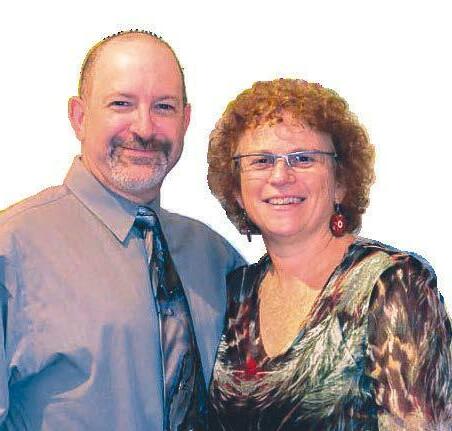

The term “elder orphan” describes someone older than 65 living alone who has no living spouse or children to help with care needs in later life. The number of elder orphans has swelled compared with previous generations. About 25% of Americans 65 or older are considered elder orphans and of these, 69% are women.
As their need for various supports become greater, they can experience increased loneliness, isolation, financial hardship and physical and mental health problems.

The growth in elder orphans stems from many societal shifts. Lower rates of marriage since 1982 and lower childbirth rates since 1971 represent a big factor, according to the Centers for Disease Control and Prevention. “Gray divorce” has also contributed to the rise in elder orphans, as the rate for those 50-plus has doubled since 1990, states a 2017 Bowling Green State University study.
Financial and life planning can help mitigate the effects of lacking family support.
“I have a few girlfriends who are in that situation,” said Henrietta resident Debra Kostiw, author of
“Forget Me Not: The #1 Alzheimer's and Dementia Guide for Professional and Family Caregivers,” who often speaks on elder issues. “I often think of them and wonder what they are going to do. Who will be their advocate and stick up for them? I’ve seen people get bulldozed over who have a good support network.”
She encourages people to begin building their support network in their 50s and 60s by joining groups, including a religious body, clubs and more. Building those ties helps people stay connected to their community and to resources that can help them age well.
“As we age, we tend to get more isolated,” Kostiw said. “Keep those lines of communication open with others.”
She further recommends lining up two or three trusted people good with decision making and aligning with one’s wishes to designate on a power of attorney and a health care proxy. The power of attorney is a legal document that allows another person to make financial decisions on one’s behalf. The health care proxy names a person to make healthcare decisions. In both cases, the person designated is
obligated to carry out the designator’s wishes.
Kostiw encourages people to share contact information among all of their helpers — such as a housekeeper, driver, care companion and trusted neighbors — so they can keep everyone aware of needs as they arise.
Choosing an independent living community may seem like a good option to provide a continuum of care into assisted living and then nursing care. However, Kostiw warned that the continuity is often lacking, as residents may be moved to the other side of the campus once their needs escalate.
“Their belongings and chart will go with them, not the dining staff and housekeeper,” she said. “It’s a completely different staff of people. Some communities are better at this than others, but what I’ve seen the staff isn’t discussing all the person’s favorite preferences. It’s not the person-centered care we hope it is.”
Christine Peck, licensed master social worker and associate vice president of programs at Lifespan of Greater Rochester, said that older adults who lack children and friends to name on their healthcare proxy and power of attorney documents
should look at a private geriatric care manager or management group. These professionals can discuss the client’s goals and needs of how they want to be represented as their needs change.
“Some choose a licensed and bonded fiduciary,” Peck said. “Choices of that could include an attorney, financial firm, aging life care manager or aging services community-based organization.”
Others in the community can help too. Peck encourages older adults to maintain a close relationship with their primary healthcare provider and to use the services such as nurse care managers and social work available.
Technology can make life easier as an elder orphan, but it is key to start using it early to build familiarity. Many libraries offer free computer lessons. Instructors such as Daniel Jones of Daniel Teaches also provide one-onone help.
Automate banking, bill paying and grocery delivery to make it easier to get things done and reduce the need for driving. Scoping out transportation options early can make it simpler to use it when it is need. Check into what ride share and public transportation options are available. Some religious organizations offer a senior ride ministry, and some municipalities provide low-cost or free scheduled rides. Look at meal delivery options, including Grub Hub to obtain restaurant food or Meals on Wheels. Try meal kits such as Hello Fresh and Blue Apron or heat-and-eat choices like Real Eats. As cooking becomes more challenging, these choices can lighten the load.
“Prescription delivery is another option that a lot of people aren’t aware of or even if they are, view it as a service that one would use temporarily during an acute health issue,” Peck said.
Most local pharmacies will also deliver a few other items along with the medication.
Peck also encourages older adults without children or spouses to reach out to a companion care agency, even if they do not need many services.
“Having that group know you and have an understanding of you will make it so much easier if your needs increase in the future,” she said. “You’ll have someone to help advocate for you.”


Sharon Grasta, owner & operator of Grasta’s Beauty and Wig Studio works with you, one-on-one, to supply the perfect item for your unique needs. “Wigs, headscarves, accessories – everything I offer here is top-quality and hand-selected to ensure your experience is ideal. Consider me the manufacturer of natural looking hairstyles.”
Physicians, hospitals, nurses, support groups – all kinds of people and patients recommend Grasta's for my broad and varied selection of beautiful wigs!











Along with an exceptional inventory of today's finest wigs, Grasta's also offers many accessories, products and guidance to help you complete your individual look!



“Sharon was so kind & understanding and she had lots of hairpieces to choose from. She knew exactly what I needed. I loved her right away because she showed me what was good on me & the ones not good on me. Sharon was always patient with me... Sharon loves her customers and it shows in how wonderful she treats them: like family.” - Mrs Ann M. Colarertalo

Due to COVID-19, strict safety policies are in effect and apply to EVERYONE. We cover our styling chair in disposable vinyl. I also wear protective coverings. There is no way an operator could be three feet apart from a client while working, which is why the client and I are covered. You will receive foot coverings, vinyl gloves and a sheer vinyl cape which you will wear out to your car and discard at your convenience. Temperature will be taken at the door. No wigs are touched by bare hands. ONLY THE CLIENT IS PERMITTED INSIDE!
Mama Cindy Strasburg shows what one of her diddy boxes looks like. These are wrapped, sealed, and packaged in a much larger box for shipment to someone on active duty, and that person will distribute the smaller boxes as the "mailman."
It's not unusual for Cindy to adopt a whole National Guard unit being shaped overseas for the duration of their tour.
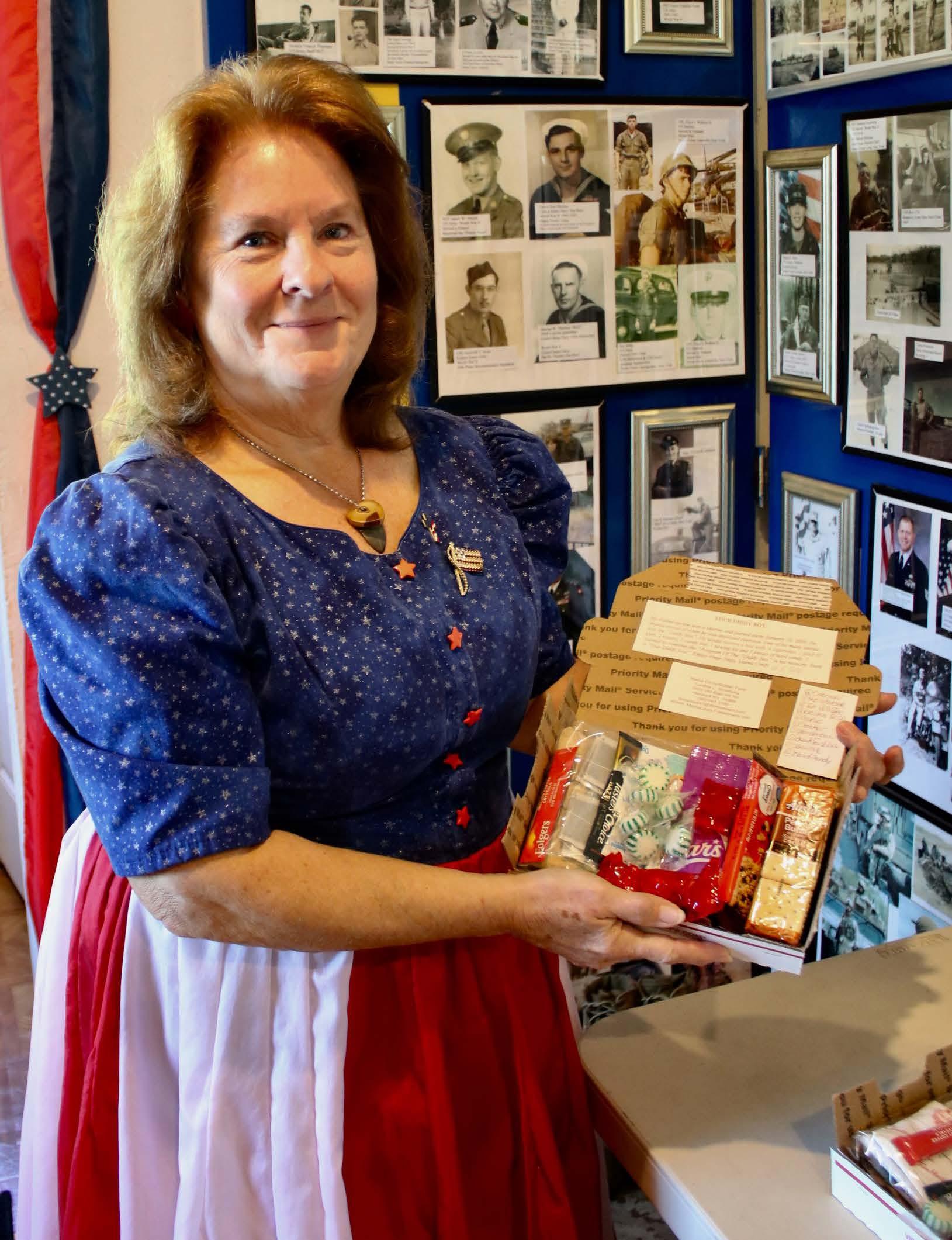
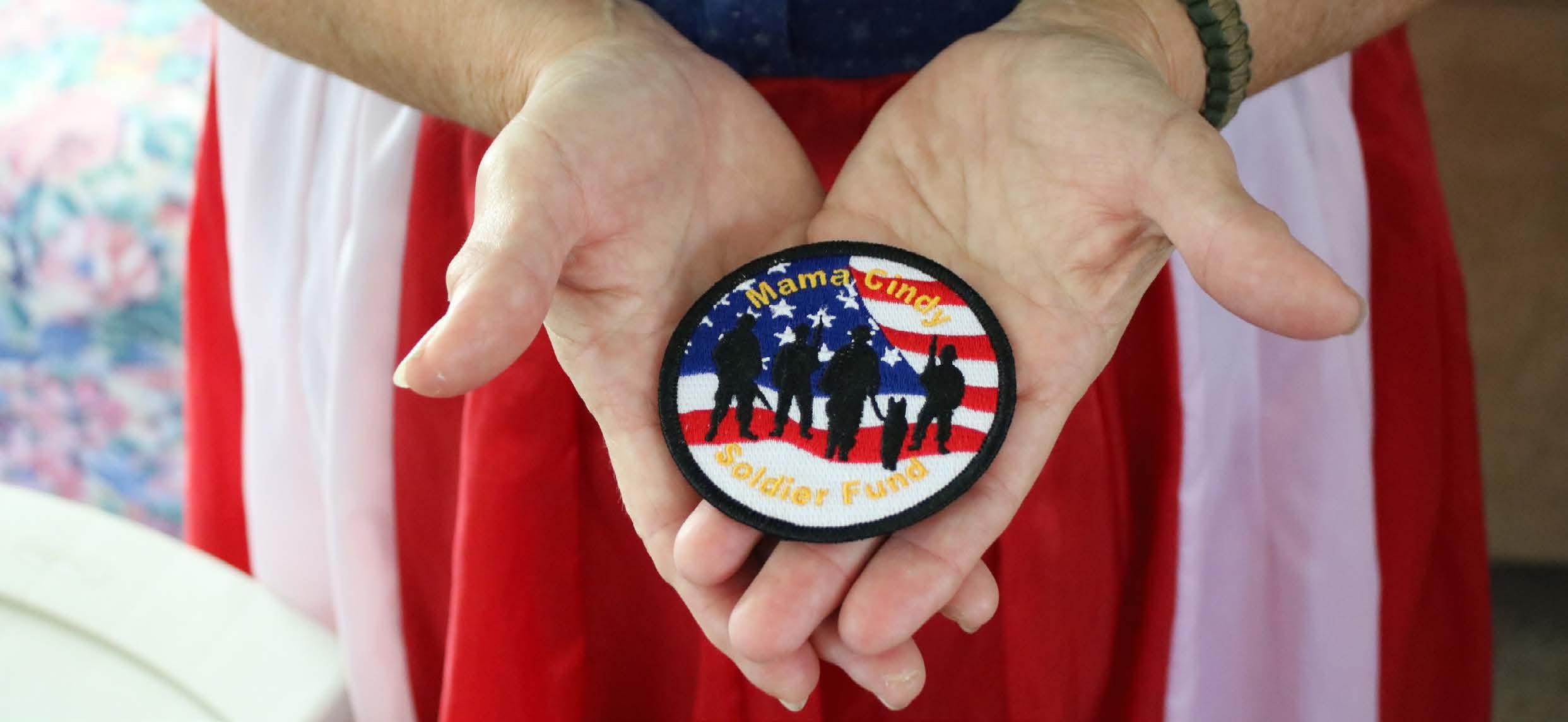 By John Addyman
By John Addyman
How big is your heart?
We all have good intentions to be our brother’s and sister’s keeper. But how far do those intentions go?
How would you react to a need that you know others view as being too difficult? Too personal? Impossible for one person? Too time-consuming? Too expensive?
Those questions breezed through Cindy Strasburg’s mind in 2005. “Breezed” because she immediately set them aside and went to work.
Every weekend Strasburg, 66, living in the middle of God’s country in Livingston County, in the town of Hemlock, sends out packages to American sailors, marines, soldiers, coast guardsmen and airmen all over the world.
She averages at least 100 of those packages a week. She calls them “Diddy Bags.”
More than a century ago, sailors
would pack their most valuable personal items in a small wooden box, a “ditty box.”
Often, the ditty boxes were decorated with scenes of ships or far-off places. What Strasburg sends out is the size of a post office flat-rate box, stuffed carefully with goodies and useful items.
But there’s so much more.
With each diddy box that goes out, she includes a handwritten note to the soldier. She adopts a whole unit, packing smaller boxes into bigger boxes and sending everything to one person. Then he or she distributes all the small boxes or items to individual soldiers.
All of this started in 2005.
“My friend, Wendy Parcels, we were in the fire department and the Hemlock Fair Association together — got orders to go to Iraq with the Army National Guard,” said Strasburg. “She sent me an email from Iraq that said, ‘I wish I had brought some heavy slippers or socks because it’s so cold
over here.’”
“She was a material readiness officer. She provided supplies for the top third of Iraq,” Strasburg said. “I went to my local Livonia American Legion Post and said, ‘I’ve got a soldier who made a wish and could we grant that wish for her?’ They gave me a $100 donation and I bought enough slipper socks and socks for the whole unit. I told Wendy, ‘Wish granted. Make another wish.’”
“It started with that one wish,” Strasburg added.
Over time, she found out what soldiers wanted and needed.
“Wendy is an officer who supplies for many soldiers,” Strasburg said. “I sent her supplies to reach soldiers of need. That became her connection for the rest of her tour. There are so many soldiers of need who can’t go to a PX or commissary; they’re in an outreach area. She got my packages to them.”
“A lot of soldiers just want a connection home. When they would write me about things they’d miss, I would grant their wish in a different way,” she said.
To help crush the nothingness of downtime in service life, she developed a Take A Soldier to the Movies program.
Dansville Home Video got on board and donated VHS tapes and then DVDs, hundreds of them.
“I sent my soldiers the movies and all the fixings — popcorn and candy bars. The store supported me until they went out of business,” Strasburg
Patch of Mama Cindy’s Soldiers Project, started in 2005 by Cindy Strasburg, 66, of the town of Hemlock in Livingston County.said. “One group wanted, since it was so warm out, to have movie nights. So I sent them a king-sized white sheet to use as their screen. I sent a note and said, ‘I couldn’t send you a big-screen TV, so here’s your sheet: make it work.’ And they had outside movies.”
A seamstress by trade, Strasburg would make small items for her soldiers and she developed a system for her diddy boxes.
The first shipment, an introduction, contains travel snacks.
Next week, soldiers — male and female — receive personal care items.
“I had 23 soldiers in one unit, I told them, ‘You’ll never have to buy a toothbrush or toothpaste or dental floss as long as you’re there.’ I sent enough for the full unit,” she said. “That week the package was entirely toothbrushes, floss and toothpaste.”
In the third week, packages contain reading and writing materials.
The fourth week takes care of the feet — socks, foot powder and soles.
After that, soldiers have an expectation and make-a-wish starts.
One overseas unit asked for fidgetspinners (ask your grandkids) and she got them. Another wanted little battery-operated personal fans. She got them shipped out.
“I’ll send breakfast, instant
Mama Cindy in her workroom. This is where the magic happens, where supplies are brought in, repackaged and sent out all over the world to the units Cindy has adopted. On the wall behind her are photos sent to her by soldiers who have received her packages.

Where does the money for all this come from? In the beginning, it started with that $100 from the Livonia American Legion and tips from her seamstress customers, who themselves became donors.
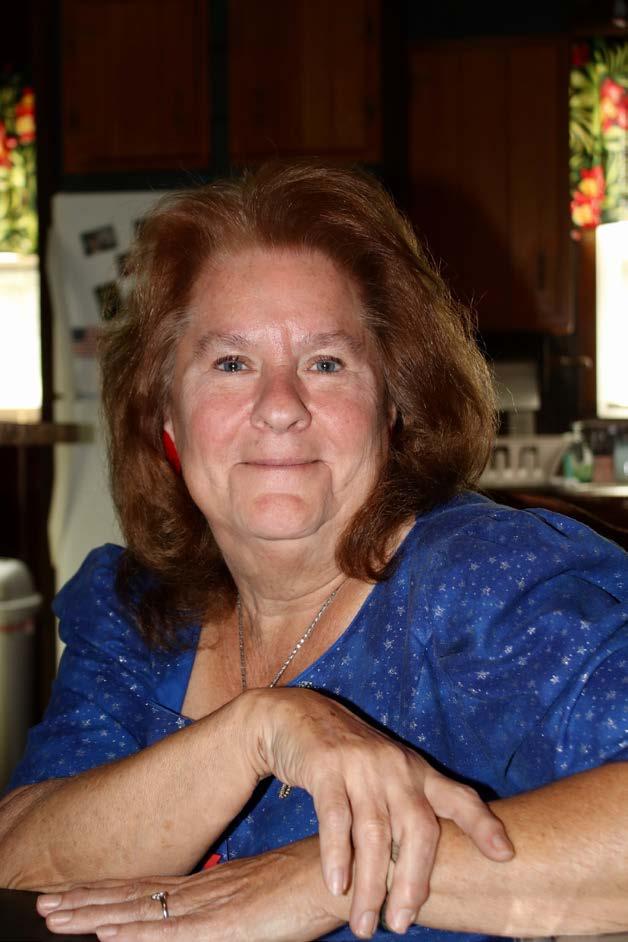
Strasburg applied for and received grants. It was something she had also done for the fair association.
Motorcycle clubs donated proceeds from their charity rides.
In her weekly trips to the post office — another adventure — she often runs into people who “see me coming in with my packages on a trolley and when I tell them this is for soldiers overseas, I’ve gotten many donations right there in the parking lot. They’ll give me $20 and say, ‘I hope that helps.’”
Many people and groups donate supplies. People from far away have purchased vanloads of supplies and brought them to her or met her in Geneseo for coffee and a load-swap.
oatmeal hot cocoa, coffee, tea, sugar, drinks-to-go mixes, cookies, crackers, granola bars, trail mix, hard candy, Slim Jims if I have them,” she said. “In wintertime they get chocolates, as much as I can send.”
“One unit was in-country and said to me, ‘There’s nothing here to do, there’s no gym, there’s no PX, there’s no commissary, there’s nothing. You send us a ball we’ll figure out a game.’” She continued. “So, they got three huge boxes — they got volleyballs, they got hand-throw balls, badminton rackets and birdies, tower puzzle games, playing cards, dice and checkers.”
“I put everything in a zip-lock bag (there’s a lot of dust and sand in the deserts and mountains). Ninety percent of what I ship comes out of the original package and goes into a ziplock bag. If it’s a food item, I’ll include the ingredients label so they know what’s in the food item. They have to burn and destroy all the packaging. I don’t pack food with personal care items because you don’t want your food tasting like soap,” she said.
A Special Forces kid in Africa wrote to her —“Mama Cindy, I’m going to get burnt in Africa.”
“I told him, ‘The first package will have sunscreen and Chapstick, she said.”
And there’s no mystery about how she affords what she does. It’s all detailed by the month on her Cynthia Strasburg Facebook page and on her website www.mamacindy.freeservers. com.
The donations and who sent them, the expenses for buying items and the shipping are listed to the penny. On the wall of her immaculate workroom in the back of the house she has a sign noting that she’s spent $164,000 on troops since 2005.
The accounting of what comes in and what goes out gives a professional reassurance to people who donate. Recording all of that is a lot of work for one person to accomplish.
Her diddy bags and packages are familiar in 30 countries around the world, to 9,000 soldiers and those serving on 14 active-duty ships.
When one of her adopted service units comes home, she picks up another.
It’s one thing to send a soldier some trail mix and socks; it’s another to decorate each box and pen a personal note citing encouragement and love.
And it’s no wonder she gets responses, which she also highlights on her Facebook and Internet pages.
“Every package gets a handwritten letter from me,” she said. “I tell them how proud I am of them and I thank
Mama Cindy Strasburg, 66, is a seamstress who has been sending personalized packages to servicemen and servicewomen all over the planet since 2005. “I’m one mother who feels you can make a difference in someone’s life,” she said.them for their service. One soldier recently told me, ‘That’s nice to hear, because I don’t hear it from the people I need to hear it from.’”
She has been a longtime doer. But her soldiers’ project is a calling.
“I made a commitment to the Lord,” she said. “My life is blessed. For me to be able to help people around the world whom I’ve never met — I am a very strong daughter of the Most High. I will not block the blessings the Lord has given me to help people around the world.”
When she married her third husband, he brought two of his children to the family. To help ease the passage to a new mom, she wanted to honor her stepson’s birth mother: she didn’t want the boy to call her ‘mom” and asked him to choose another name for her.
Mama Cindy was born that day.
She welcomes all the units she adopts with an open embrace.
That love gets returned.
“One soldier on R&R came to my house and asked me, ‘Are you going to adopt all of my soldiers?’ I said ’Absolutely.’ He said ‘OK! Hold on.’ and he called his commander overseas. The soldier said, ‘I’m at Mama Cindy’s. She’s going to adopt everyone in our unit overseas. Hey guys, I got Mama Cindy on the phone!’”
She got the roster of that unit with everyone’s name. There were 410 soldiers in that unit.
“Oh Father! I had made a promise. I made sure every one in that unit got a diddy bag with a personal note and their name on it. Then I contacted their commander and said, ‘Just to let you know you have 436 soldiers in your unit and they all got something,” she said. “Now I ask how many are in the unit.”
“Another soldier who visited was in the Army. His grandfather brought him to see me. He had come home from Afghanistan and found out his wife had left him. He didn’t want to go back to Afghanistan. He didn’t want to live anymore,” she said. “His grandfather asked me to talk to him, please. This soldier was taller than my Christmas tree. We talked.
I asked him, ‘Do you have access to the children in your area?’ He told me he did. Here’s what I’m going to do:
I’m going to send you Beanie Babies for the children and bags of candy. I’m going to ask that you hand them out to the children. I’ll be waiting for my hug when you get home. I hugged him; I still remember his shaking when I hugged him. And I told him, this is what I want when you come home. And he finished his tour and came home. He needed a reason to come home.
“If I can put in a box something that would take care of a soldier’s mental, spiritual and physical wellbeing, maybe just maybe that will give him the strength to come home to his loved ones once again.”
Strasburg helps more than soldiers.
“I got a request from a commander of a medical unit in Afghanistan who contacted me through email, saying, ‘Mama Cindy, I need your help. There was an IED that went off and an Iraqi family got hurt. The parents and one child lost their lives. We have a toddler and infant and we have nothing for them. Can you help us? I know if I go to any other organization, they’ll have to have a meeting, they’ll have to approve…but if I come to you…’
“Upstairs in the house I had received a huge donation from Dansville Hospital. I had just put it away. Everything they needed was in those bags. God had provided. I packed it and I shipped it out that very day. I sent an email to the commander: ‘Everything on your list is on its way,’” she said.
As you’d expect, Strasburg outdoes herself at Christmastime. Around Thanksgiving, she sends out Christmas cards and envelopes so troops can send them back home to their loved ones. At Christmas her diddy bags change and enclosed are her personal note, a Christmas card and gifts, which are all individually wrapped. And nobody wants for
Where it all started. Mama Cindy's Soldiers Project began with her friend Wendy Parcels, pictured here, who was a supply officer in Iraq.
Christmas candy.
One of those boxes arrived on a ship Christmas morning. Who says there isn’t a Mrs. Santa Claus?
“I’m one mother who feels you can make a difference in someone’s life,” she said. “People help in ways they can. For my soldiers, I have to make sure everything I send is perfect and of good quality. As long as I’m on this earth, this program will continue.”
“This mission was given to me by the Lord,” she said. “I had a soldier in Iraq who would call me at night – my answering machine never goes on at night. He said, ‘Oh Mama Cindy, we just got done with a mission, some of my unit was shot by insurgents; our gunny sergeant got shot and I had to administer first aid and I thought I was going to get shot. I called home and nobody answered. How come you answered?’ Because you needed someone to talk to,” Mama Cindy said.

• Supplies — Call her at 585-367-3780 to make arrangements to drop off or she’ll pick up.
• Money — Make check out to Cynthia L. Strasburg and put on the memo line “Mama Cindy’s Soldiers Fund.”
For more information, visitwww.mamacindy.freeservers.com.
no-nonsense solutions for the gritty, complex issues parents of estranged adult children face. With information gleaned from more than 50,000 families and the author’s own estrangement. Reclaim your life and joy. Start the New Year with a fresh perspective.
 winning books by Sheri McGregor, M.A.
winning books by Sheri McGregor, M.A.


Q.: Are Social Security numbers reassigned after a person dies?

A.: No. We do not reassign Social Security numbers. In all, we have assigned more than 500 million Social Security numbers. Each year we assign about 5.5 million new numbers. There are over one billion combinations of the nine-digit Social Security number. As a result, the current system has enough new numbers to last for several more generations.
Q.: Is it illegal to laminate your Social Security card?
A.: No, it is not illegal, but we discourage it. It’s best not to laminate your card. Laminated cards make it difficult — sometimes even impossible — to detect important security features and an employer may refuse to accept them. The Social Security Act requires the Commissioner of Social Security to issue cards that cannot be counterfeited. We incorporate many features that protect the card’s integrity. They include highly specialized paper and printing techniques, some of which are invisible to the naked eye. Keep your Social Security card in a safe place with your other important papers. Do not carry it with you.
Q.: Someone stole my Social Security number, and it’s being used repeatedly. Does Social Security issue new Social Security numbers to victims of repeated identity theft?
A.: If you’ve done all you can to identify and fix the problem, including contacting the Federal Trade Commission (FTC), but someone is still using your number, Social Security may assign you a new number. If you decide to apply for a new number, you’ll need to prove your identity, age, and U.S. citizenship or immigration status. You’ll also need to provide evidence you’re having ongoing problems because of the misuse of your current Social Security number. You can read more about identity theft at www.ssa.gov/pubs.
chose non-surgical CyberKnife® at HOA –offering 5 treatments instead of 35!


original diagnosis was to treat my prostate cancer with seven weeks of radiation, five days a week. I was kind of upset that I was never given the option of CyberKnife,” said Frank. “The precise radiation achieved by CyberKnife, far fewer treatments, and the personalized care I received from Dr. Chin and his team made my decision an easy one.
the treatment was a real success!”

Frank Guido couldn’t be happier he had a choice for treating his prostate cancer!








Seniors who take vitamin D supplements to improve their bone health and ward off fractures are just wasting their time and money, a major new study has found.
These supplements did nothing to reduce their average risk of bone fractures, researchers found in a randomized trial testing vitamin D against a placebo.
“In generally healthy adults, these results do not support the use of vitamin D supplements to reduce fracture risk,” said lead researcher Meryl LeBoff, a physician who serves as chief of the calcium and bone section at Brigham and Women’s Hospital in Boston. “We found that supplemental vitamin D did not reduce fractures in U.S. participants.”
In the study, published July 28 in the New England Journal of Medicine, more than 25,000 older adults were randomly assigned to take either 2,000 units of vitamin D daily or a placebo, and then followed for an average of five years. The average age of participants was 67.


Nearly 2,000 bone fractures occurred among more than 1,500 participants during the study period. However, taking vitamin D appears to have had no bearing on who suffered a fracture and who didn’t.
Nearly 20% of U.S. adults currently take vitamin D supplements, often based on blood tests that find they have “insufficient” or “deficient” levels of vitamin D.
These new results should cause both doctors and patients to question the value of routine vitamin D testing, said physician Steven Cummings, a professor emeritus at the University of California, San Francisco.
“Doctors routinely order vitamin D levels, and many patients hear that they are low, they’re below some level,” said Cummings, co-author of an editorial accompanying the findings. “What we needed to know is whether those people who have low levels benefit from taking vitamin D. And the answer to that is no.”
Diana Apostolova Investment Consultant


 cover
cover
“Erie Canal Impacts on the Hodinoshoni,” 2022 Mixed media on canvas. Image by Andy Olenick. Courtesy of the artist and K Art Gallery, Buffalo.
“Blue Whale,” 1969. Acrylic on canvas. Photo courtesy of Memorial Art Gallery, University of Rochester.
“In Our Language,” 2020. Photocollage and China marker on canvas. Image by Steven Paneccasio. Courtesy of the Forge Project.
“Dried Sunflowers (Sentinels Study),” 2006. Mixed media on paper. Image by Joerg Lohse. Courtesy of the artist and K Art Gallery, Buffalo.
By Melody Burri
teeped in history, fueled by creativity and driven by a passion for tackling the impossible, G. Peter Jemison (Seneca, Heron Clan) has been the face of Ganondagan State Historic Site for more than 35 years.
In February, the 77-year-old artist, teacher, curator, filmmaker and Ganondagan (ga·NON·da·gan) site manager retired. But make no mistake — he’s nowhere close to slowing down.

Known regionally and internationally for his artistry and visionary leadership, Jemison’s body of work and historical expertise have had far-reaching impact.
During his tenure, Ganondagan has produced multi-faceted, multigenerational events that include public lectures and performances, art exhibits and filmmakers’ festivals, treaty commemorations, living history events, indigenous music and arts festivals, bark longhouse tours and Native American winter game events.
But ask Jemison which career accomplishment tops his personal list and he’ll likely point to the 2015 grand opening of Ganondagan’s multimillion-dollar arts and culture facility.
After some 13 years of planning, the $12 million, 17,300-square-foot Seneca Arts and Culture Center became a reality. It now sits adjacent to the Seneca Bark Longhouse on
Ganondagan’s 569-acre hilltop, the original site of a 17th century Seneca town.
Designed to fit into the natural landscape, the facility boasts an interactive, multimedia exhibit gallery, orientation theater, auditorium, classrooms, catering kitchen, gift shop and offices.
Exhibits, education and performances showcase 2,000 years of the Seneca and Haudenosaunee (Iroquois) contributions to art, culture and society.
It was Jemison’s vision and commitment to ensure Ganondagan’s future that first brought SACC to life.
“Our master plan called for a new building and a key thing for me was to see that built,” he said. “I felt as though the building would give Ganondagan even more of a permanence.”
Without a structure on the site of the historic village, he said, it might have been tempting to sell off a portion of the vacant land at some point to stave off a temporary budget crisis.
But there were many disbelievers, especially at the state level.
“They thought I’d never be able to get this done,’” he said. “They didn’t believe I could raise the money and they told me so.”
Although there was no original plan for how it would all come together, the parts started to fall into place, Jemison said.
“And when that happens, I’m good at seeing it,” he said. “I found people who understood what I was doing, who I wasn’t having to try and convince — because I can’t waste my time doing that. I worked with those people who had a like mind, and I gave them a role. ‘This is what you could do,’ I said. And they became supportive.”
He remembers the day of groundbreaking vividly as cold winds and pouring rain threatened to dampen the ceremony.
“We were all huddled under a 40 by 40 tent,” said Jemison. “All of those supporters were there, getting cold and wet and dealing with the conditions. When we got ready to put the shovel in the ground, it stopped raining. I just felt so supported at that moment by the people who were there that I believed
it would come about.”
There were setbacks and some board members were ready to give up.
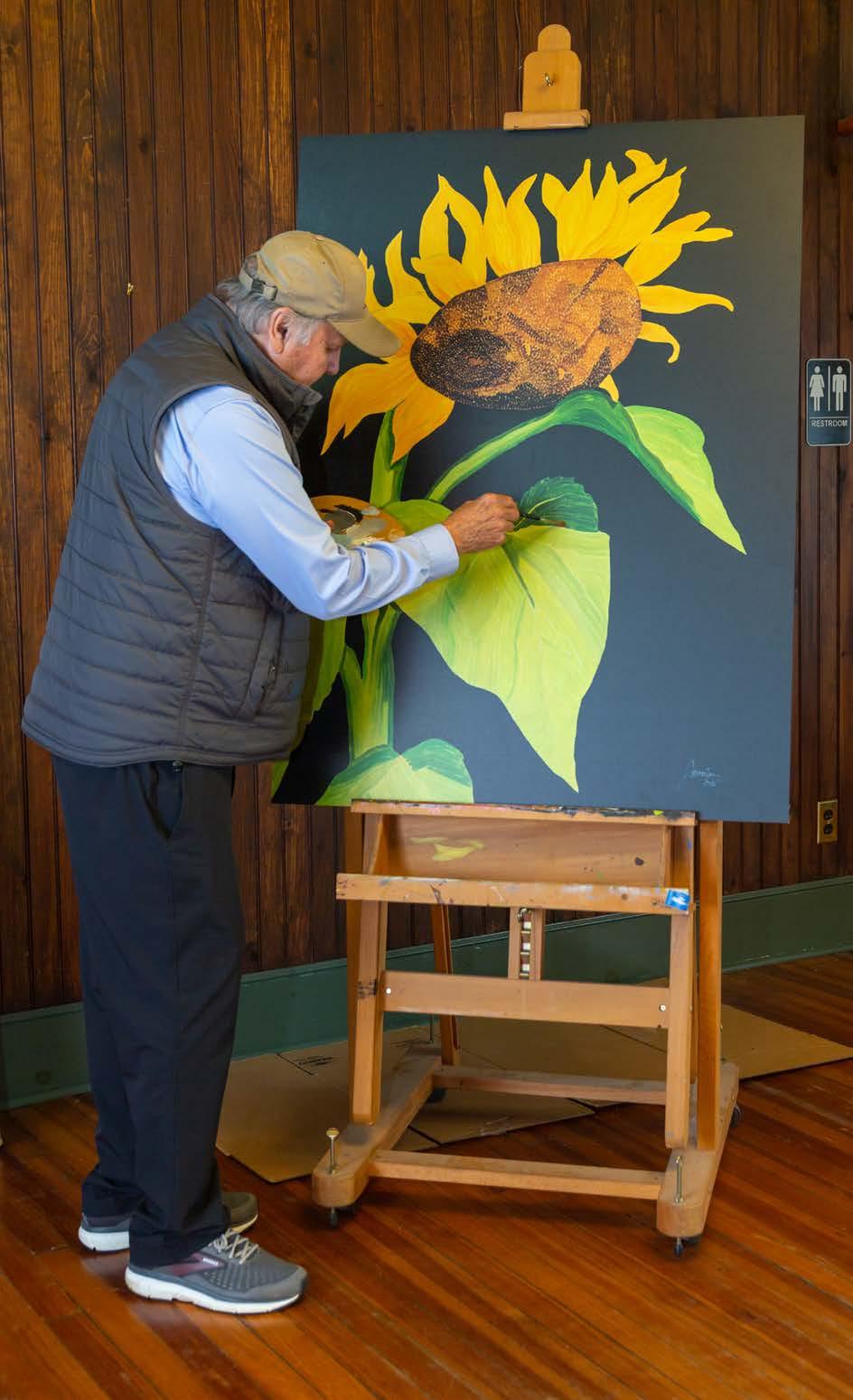

“But I said no — we’re not going to give up. We’re not going to downsize. We’re not going to stop,” said Jemison. “We’re going to make it happen. And I believed it.”
Supporters came up with solutions for the problems and the project moved forward.
“It took a few months longer than I thought, but I’d been at it for years already so that didn’t seem too bad,” said Jemison. “I had to have faith, and it all worked out. That experience still resonates with me.”
Right out of the gate, Jemison knew it would be the programming
that would elevate Seneca Arts and Culture Center beyond a typical historical museum to a place where past, present and future lived together.
“We had to consistently do some things that were unique,” said Jemison, recalling the moment his vision first materialized.
“This is exactly what I meant,” he said as he watched a guest presenter in action. “This is what I hoped it would achieve.
“She talked about food sovereignty, our relationship to the environment, our protection and understanding of the fact that we are a part of the environment around us and that we have a responsibility to the living things and the living things are a gift to us,” he said.
“Understanding those things and seeing that women have a primary role
“You cannot talk about what you would do — you can only show what you have done."Photo courtesy of Melody Burri
in our way of life helps to explain who we are as the original people of this country,” Jemison added.
The museum has proven to be so much more than “a collection of things.”
“We’ve achieved the goal of this building, which is to have it be alive and ongoing,” he said. “So even as we tell the story of what came before, we have to have a living presence.”
The center’s exhibits use three essential components — first described by Jemison’s mentor, John Mohawk — to help guests know and understand the past: oral tradition, written record and archeology.
Oral tradition is passed on to younger folks so they’ll not only understand it, but be able to teach it to the next generation, Jemison explained.
“Then there’s a written record recorded by people who visited,” he said. “But that wasn’t always accurate because they didn’t have the gift of our language and came from such a different experience that they weren’t always correct in what they thought they saw. These are the people who
created maps and captured the things nobody else was around to write about.”
Archeology yields tangible proof of what was traded, created and valued — these artifacts have their own specific stories to tell, Jemison said.
After 37 years at the helm of Ganondagan State Historic Site in Victor, Jemison passed the leadership baton in February to his youngest son, Ansley Jemison (Seneca, Wolf Clan), and longtime Ganondagan historian and curator of the Seneca Art & Culture Center, Michael Galban (Washoe/Northern Paiute).
Ansley Jemison now serves as cultural liaison, and Galban as site manager.
“I knew who I thought could carry on the work I was doing,” said Peter Jemison. “I knew my youngest son could be important to help. So he had to go through an interview process and luckily he came out on top. He’s doing a good job and has his own ideas of
what should be done.
“Michael Galban had been with me for 30 years. He knew what he wanted to do and how to keep things going. So we divided my job into two people and it’s working so far.”
The site is a National Historic Landmark and is listed on the National Register of Historic Places.
“The purpose of art is to help people see,” said Jemison.

And that’s exactly what he’s done for decades.
Widely shown and collected, Jemison’s works are rooted in the framework of Native American art. His art embodies orenda, the traditional Haudenosaunee (Iroquois) belief that every living thing and every part of creation contains a spiritual force. His paintings, videos, and mixed media works explore a variety of topics, including political and social commentary and his relationship with the natural world.
Jemison has participated in numerous solo and group exhibitions in the U.S., the U.K. and Germany. Original creations in colored pencil, oil pastel, grease crayon, pen, acrylic, gouache, egg tempera, watercolor, fresco graphite and handmade and black paper are on exhibit in multiple locations.
“If you’re an artist, your art can only be appreciated if it’s seen,” said Jemison. “And for a long time my work was really not seen. Those who control the museum, publicity and art world didn’t see why Native American work was important. So my art was really unknown. But I kept working.”
For decades, Jemison has been driven by the certainty that an artist cannot talk about what they would do — they can only show what they have done.
“If you have the opportunity to exhibit, you can’t be standing there talking about what you would have done or what you wanted to do,” he said. “You have to have there someplace what you did do. And it has to keep evolving. You have to keep working.
“Art is the long road. “It takes a long time. And even in my lifetime, maybe a judgment is made (about my work). And whether that judgment is confirmed will only be known long
LEFT: Peter Jemison stands in the main gallery at the Seneca Art and Culture Center in Victor. Photo by Melody Burri MIDDLE: Peter Jemison works in his studio on Railroad Street in Victor. Photo by Melody Burriafter I’m gone. They’ll decide whether what I was doing was really important or not.”
In this stage of life, Jemison’s work and accomplishments are gaining prominence and he’s busier and more in demand than ever before.
“For instance, the Museum of Modern Art — I would have said the Museum of Modern Art is in New York City and I’m over here so we won’t be connecting,” he said. “But we are connecting and it’s with people who run the place and decide what they show and do and buy and collect.”
It’s gratifying, to be sure, but each request requires multiple steps and takes more people to help deliver what’s requested.
“So I do the best I can to keep up with this stuff and I’m very lucky right now,” said Jemison. “Fortunately for me, in the beginning I found a very good partner and she has stayed by my side and has helped me hold it
together. She is the one who really knows what the real deal is — and she still likes me — and that’s really remarkable.”
Throughout his life and career, Jemison said it’s never been a question of whether he could get something done or not. And he never thought if he sat around thinking about something, it would magically happen.
“I knew that to get it done, I would have to take action,” he said. “And I’ve never been afraid to do what nobody else could figure out how to do. I try to figure out how to be a force for positive.”
He continues to take action, create inspiring, insightful art and enjoy each step of “the long road.”
“When you’re the beneficiary of a lot of good things,” said Jemison, “you really need to count your blessings and attempt to live in the moment — to understand and feel what you’re doing and to feel good about it. ”







 By Mike Costanza
By Mike Costanza
‘I had always wanted to play Santa,’ says Jeff Meteyer
For Jeff Meteyer, the best part of playing Santa Claus is working with kids.
“It’s one of the most recognizable ways to establish a bond with a child,” the 57-year-old West Irondequoit resident says.
Meteyer and his live-in girlfriend, 62-year-old Gemma Divine, have played Santa and Mrs. Claus for about four and a half years, bringing the feel of the holidays to everything from house parties to municipal Christmas tree lightings. They’ve already donned their costumes for events this year, and are looking forward to helping little ones and their families celebrate the coming holidays throughout Monroe County and as far away as Corning, Steuben County.
It all started for the pair back in 2018. Meteyer was newly divorced and facing his first Christmas alone and without young children — all three of his kids are grown. Seeking an opportunity to interact with little ones, he decided to follow a longtime dream.
“I had always wanted to play Santa,” he says.
Meteyer already had a curly, white beard and mustache, and bought a Santa Claus costume to go with it. He got his first chance to play St. Nicholas when a friend of Divine’s complained of not being able to hire someone to play that role at a family Christmas gathering. Meteyer donned his costume, Divine put together a “Mrs. Claus” outfit and the couple brought some cheer to their friend’s gathering.
“We had a ball!” Divine says. “We just laughed all night long.”
The pair enjoyed it so much that they decided to look for chances to play the jolly old elf and his wife for a fee. A visit to the Corning Museum of Glass for the 2019 Christmas in July celebration led to their first paying gig. The museum’s regular Santa could no longer do the job, and its staff was desperate for a replacement.
“I was basically hired sight unseen,” Meteyer says.
Meteyer and Divine played Santa and Mrs. Claus for a series of breakfasts and lunches at the museum
that year, and have returned every year since then but for 2020, when COVID-19 forced the cancellation of the events. Altogether, the two have played Santa and Mrs. Claus at family parties, celebrations at shopping malls, municipal tree lightings and other events at least 100 times down through the years. They’ve even played the office party for the University of Rochester’s information technology department, where Metyer works fulltime as a reporting manager. In addition to playing Mrs. Claus, Divine is employed full-time as a licensed medical technologist.
Though Meteyer’s belly shakes when he laughs, he doesn’t do some of the other traditional Santa stuff.
“Ho-ho-hoing is one of the least things I do,” he says. “I would qualify myself as more of a quiet-toned Santa.”
Instead of sitting on a large chair, Meteyer perches on a kind of love seat and invites kids to either sit on his lap or on the seat, whichever is more comfortable for them.
“They can have their parents sit on the chair with them, if they wish,” he says.
The approach is less apt to intimidate children who might be nervous about meeting a 5-feet-10inch, 249-pound stranger with a sixand-a half-inch beard. Children can put their Christmas wish lists in a kind of mailbox that sits nearby, but some prefer to just talk to him.
“They actually do want to have a conversation, and ask questions about ‘How did you get here? Tell me about the reindeer. Where’s your sleigh?’ those kinds of things,” Meteyer says.
Such times keep him donning his costume year after year.
“I enjoy seeing how kids communicate, how they get excited about the experience to be able to talk to Santa, and their reactions when someone is intently listening to them,” he says.
COVID-19 cut into Meteyer’s ability to communicate with kids. During the pandemic, he and the kids had to wear masks and stay 6 feet apart. If they touched his costume, he had to spray it down with disinfectant.
“I’m sure at some point, some kid was saying ‘Why does Santa smell like Lysol?’” Meteyer says.
While Metyer entertains the kids at an event, Divine walks the line of those waiting to see him clad in a full Mrs. Claus costume.
“I definitely look the part,” says the West Irondequoit resident and grandmother. “I’m short, I’m chubby and I’m gray.”
Part of her job is to calm down kids who are growing too excited about seeing Santa.
“I visit with them while they’re waiting,” Divine says. “We chat about what they’re going to talk to Santa about.”
In rare cases, the kids become so nervous they break into tears. That’s when the candy canes come out.
“Sometimes you pull a candy cane out of your pocket and they dry up just like that,” Meteyer says.
He and Divine only hand the candy out with the permission of the adults who bring the kids.
In addition to the love seat and mailbox, Meteyer and Divine bring a pair of folding Christmas trees as decorations. They also hire photographers to digitally capture kids’ and families’ meetings with them. Sometimes the adults they encounter make the best pictures.
“When we walk into a room with a bunch of grownups, they are 10 years old again,” Divine says.
Meteyer’s day as Santa doesn’t really end until he’s back home, and has read all the letters to Santa and wish lists in his mailbox. One from a 9-year-old girl who had been adopted really hit him.

“She said ‘I want to be able to spend my Christmas with my mom,’” Meteyer says. “You will find me sometimes with a glass of milk and cookies bawling like a baby reading some of these wish lists from the kids.”
The holidays are Meteyer and Divine’s busy period, but they can begin doing beach photo shoots in costume as early as June and holiday events as late as the first week in January. After that, the local Santa Claus shaves off his whiskers, only to begin re-growing them in March.
Those wishing to hire Metyer and Divine to play Santa and Mrs. Claus can go to www.gigsalad.com and look for “Mr. and Mrs. Claus.”
Whether a holiday present or a birthday gift, you want to give your grandchildren something they will enjoy.
Oftentimes, their enthusiasm for a popular toy fades quickly. Or that must-have garment is quickly outgrown or deemed out of style.
Try these tips for giving gifts that last:

1. A day trip.
A gift card to a venue such as The Strong National Museum of Play, Sonnenberg Gardens, Long Acre Farms, Geva Theatre will foster memories that will last a lifetime. Indicate in the card whether you will take them or if this is a gift for their family to enjoy. Some venues offer season passes. Or print out your own gift card for a day of fishing, skating, geocaching or other new activity you could enjoy together.
2. A new hobby.
Although character-driven toys may wax and wane in popularity,
the tools they need for a new hobby may spark a lifelong interest, such as a telescope for astronomy, a sewing machine for clothing design or a musical instrument with lessons. First ensure that your grandchild is truly interested in this hobby and invest in mid-level gear with the basic accessories they will need to try it. If the equipment is too low-end, then the experience will be frustrating. There is no reason to buy top-of-the-line items in case your grandchild does not like the new hobby after all.
Whether a printed magazine or a digital one, children and teens still enjoy reading periodicals. Look for a niche periodical that aligns with their interests or a more general one, such as Highlights, National Geographic Kids or Cricket. Or consider a movie or music streaming subscription.
Keeping a fish, cat or dog teaches children self-sacrifice and responsibility. You should only
purchase a pet for a grandchild if you have cleared this choice with the grandchild’s parents. Chances are that surprising the parents with a pet for a grandchild will not go over well. It is also wise to present a gift certificate for the pet so the child can select the animal after the hubbub of the celebration has died down. Shelters overflow with pets after holidays because of impetuously given animals. Having the grandchild choosing the animal also helps ensure a better fit. Do not give rabbits or other exotic animals to young children or those inexperienced in pet care. Exotic pets require more specialized veterinary care and hardto-find food. Mass retailers carry cat, dog and fish products, but seldom carry products for rabbits, guinea pigs and hamsters. These goods are available at pet stores or farm supply stores. You could tuck a gift certificate into a new pet bed or carrier along with a stuffed animal and pet accessories. Pet stores aren’t the only source of pets. Consider arranging an adoption through Lollypop Farm, the Humane Society of Greater Rochester. Many young, healthy pets are available to take home.







 Christina Lambert of Ovid heads a team of dog rescuers, Casey to the Rescue. Photo of John Addyma
Christina Lambert of Ovid heads a team of dog rescuers, Casey to the Rescue. Photo of John Addyma
Christina Lambert sees it all too vividly. One day a dog is a beloved member of the family. The next day, the family is dropping off — surrendering — the dog at a facility. They hope, perhaps, some lucky new family will rescue the dog.
Realistically, it’s a shallow hope.
“People don’t understand that dogs that have been surrendered by their owners are usually euthanized first,” Lambert said, her voice pained. “Surrender dogs, nobody is looking for them. They’re scared. Their world has changed drastically.”
And they don’t know they’re about to cross the rainbow bridge in a hurry.
But if the dogs are lucky, Casey to the Rescue swoops in to save them.
Lambert, 58, of Ovid, heads a team of dog rescuers. Her organization, Casey to the Rescue, is named after Marine Corporal Casey Owen, a wounded warrior who inspired Lambert after getting seriously wounded in a rescue mission for which he volunteered.
She has literally grabbed dogs just minutes before meeting their maker, driving them safely to a receiving shelter and helping them — not unlike an underground railroad — to find a new family in Pennsylvania, New York, New England and Canada.
About every two weeks, Lambert and a co-pilot (Carmel O’Kane or Sue Jackson) start their journey from the
del Lago Resort & Casino parking lot on a Friday morning, a trip that will end in Lexington, Kentucky, 10 hours later. The next day at 7 a.m., cars arrive with dogs that will be put on the Casey shuttle — 40, 50 or more of them; along with some cats.
By 9 a.m., the trip back to Rochester begins with stops in Erie, Pennsylvania, Buffalo and Syracuse. At each stop, drivers from other dog rescue agencies are prepared to take the dogs to their shelters, to foster homes or to a forever home.
In less than a day’s time, a lot of dogs have a whole new horizon in front of them, courtesy of Casey to the Rescue.
At the trip’s start is Shelly Phillips Wright in Lexington, Casey’s coordinator.
“She rounds up the dogs to be saved,” Lambert explained. “Rose Ann Geller White in Syracuse finds receiving shelters for the dogs, which is a huge task, non-stop.”
It’s all computerized. When Lambert gets in her 2016 Ford Econoline shuttle bus, adorned on the outside by portraits of the pups she’s brought north, she knows pretty much how many dogs and cats she’s going to pick up, what breeds are represented and where there’s a shelter or home waiting for each dog. It’s a canine block chain.
Helping out when the dogs are being loaded in Kentucky is expert dog handler Lydia Graves, who may

trail Lambert north to Erie with a load of puppies who can’t be placed on the shuttle.
Every dog making the trip is loaded into a crate and many have new collars before getting on the shuttle.
“The dogs are all nervous,” Lambert said. “It’s rare to have a happy dog just walk into the shuttle. I did have one that was just surrendered by a family — the kindest, sweetest dog, hopped right into the crate. Sometimes we have to pick them up, coax them. Lydia is a champ and so is Carmel. The dogs that are super scared; it takes all three of us to get them calm. We’re not dumb about it: every dog is capable of biting you, but I’ve never gotten bitten on transport.

“Cats are usually quiet until about the end of the trip, when they’re getting hungry. We don’t open their crates. There’s a litter box in there. They don’t make any noise.”
The dogs bark as they’re getting loaded in the morning. And they keep barking for about 10-15 minutes, then they realize they’re on a trip and settle down. Many enjoy staring out the windows of the shuttle.

On the road, gas stations are an
experience. The dogs start barking as the shuttle slows. That draws interested onlookers and spectators who see the big dogs painted on the side of the shuttle and hear what’s going on inside. Lambert and her co-pilot explain the dogs are being rescued.

“I pulled into a gas station along the way with 70 animals barking and I had people walking up and handing me $20 in cash,” she said.
Casey to the Rescue exists entirely on donations.
Lambert got going with a grant and donations from friends and customers. She needed $31,000 to buy the shuttle, a former church bus and cover expenses, including $700 in gas for each trip.
“We’re strictly run by donation,” she said. “We’re not paid by anybody. A lot of my donations come in from my fantasy football customers. I have a link on my website (CaseyToTheRescue. com) for donations (or CTTRescue@ gmail.com and Paypal). A lot of my friends know my passions and have
written me a couple of checks.”
One second – fantasy football customers?
“I work for the Fantasy Football Players Championship (FFPC),” she explained. “I’m customer service. We’re a large, season-long fantasy football company. We host events in Las Vegas. We’re only football. That keeps us busy enough. We have a niche market. We have a season-long, very loyal customer base which is a key reason for our donations. My customers have caught on to my passion. One just literally called for my address and told me, ‘I’m sending you a check.’ About a dozen have sent me donations, just by word of mouth.”
After graduating from SUNY Cortland, Lambert worked sideby-side with her mom and dad at their Gehring Pump Co. She started working for DraftSharks.com, another fantasy football organization in 2003 and joined FFPC in 2008.
“They come out and draft live at U-shaped tables at Planet Hollywood. They’re there for five days for the first weekend of the NFL fantasy draft — we have a huge party the night before the first game on Thursday night,
LEFT On the way to new homes, the two dogs are alert but calm inside the Casey to the Rescue shuttle.
MIDDLE Lambert stands between dog crates inside the Casey to the Rescue shuttle.
RIGHT Chris Lambert stands at the door of the Casey to the Rescue shuttle she uses to transport dogs to a receiving shelter or to a new family.
at Planet Hollywood. They’re all watching the game, partying, eating food and visiting one another.”
How it started
Lambert started transporting dogs six years ago with East Coast Paws.
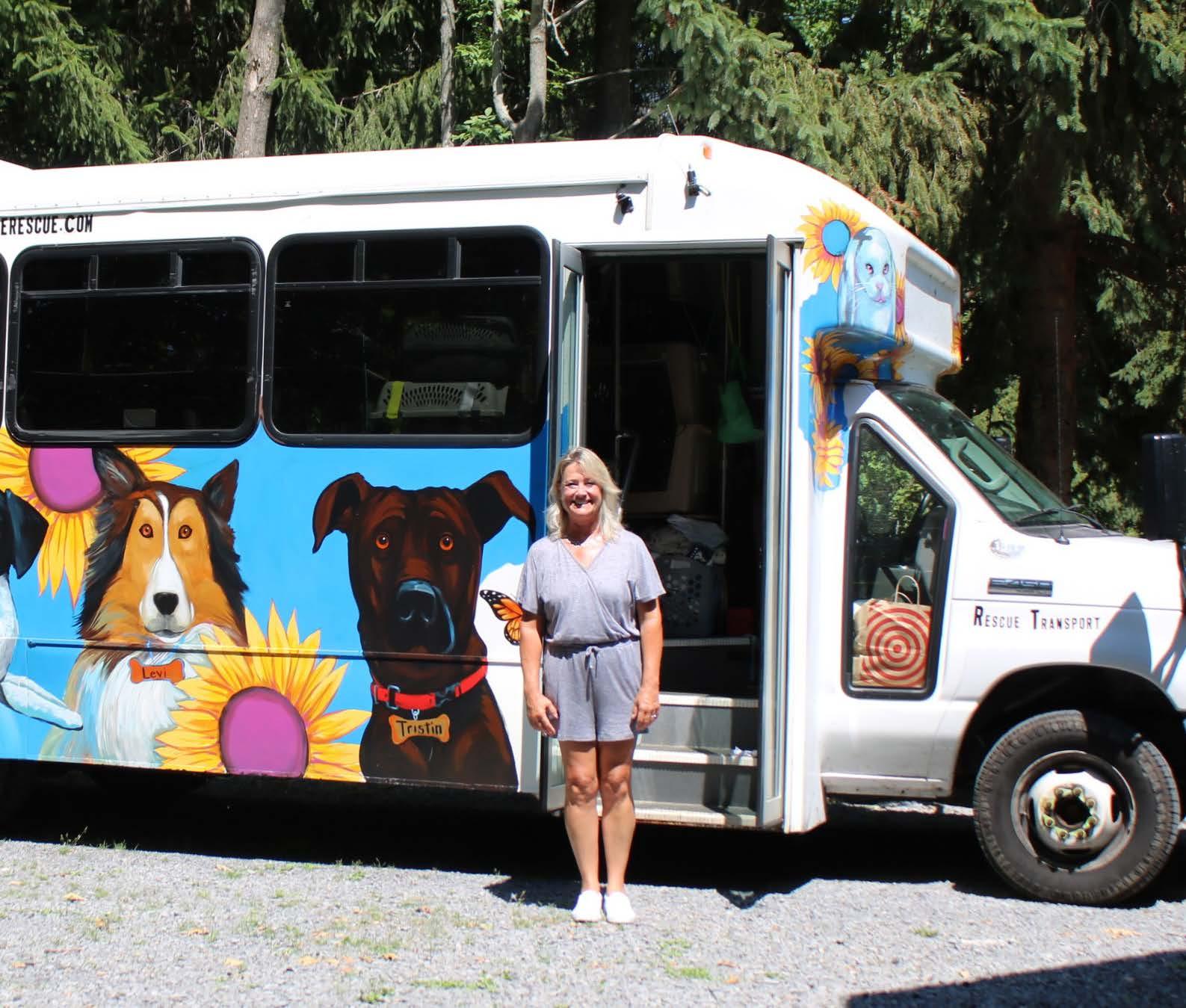
“A friend of mine had come across an ad on the internet that they were looking for help. I rode with her one day and we picked up just one dog and I thought, ‘Well, this is kind of neat.’ I put in my name for a volunteer and started driving 10 dogs in my car, from Buffalo to Rochester, then Buffalo to Syracuse, then from Erie to Syracuse every two weeks.”
She tells the story about the origin of Casey to the Rescue: “An elderly man owned an old limo bus and out of the kindness of his own heart, he would put his own gas money in the tank and drive the shuttle bus. Two years ago, that shuttle bus caught on fire, so we had nothing. He was driving from Kentucky to Erie and then straight back in one day with dogs. We would all meet him with 10 cars in Erie and pick up the dogs.
“With no shuttle,” she continued, “we were not going to be able to
save these dogs anymore. We were piecemealing it together with renting a truck or begging a truck here and there and I finally said, ‘This isn’t going to work. Now hundreds of dogs are going to die.’”
East Coast Paws had been set up to rescue dogs out of Kentucky and now its mission was dissolving, she added.
“So, I decided to purchase a shuttle (and she laughs), and to form a 501(c) (3) charity and raise some funds,” she said.
Friend JoAnn Campbell helped with the legal work on the 501(c)(3) and with fundraising.
“We did a basket auction that raised a couple thousand dollars. I received a woman-owned business grant. Tim Lambert “is always hitting up his golf buddies for donations,” she said.
She bought the shuttle in January.
“When you purchase a shuttle in January and they tell you the air conditioning works, don’t believe it,” she said.
There are mysteries to dog adoption.
“Some people just adopt dogs from a photo. Everybody asks me, ‘I’m looking for this type of dog.’ I
have a link on my website that has the receiving rescues on there. If you live in, say, Syracuse, there are Syracuse rescues listed there. Pictures of the dogs scheduled for the trip are sent to the various rescues. You have people looking for, say, a dachshund. Rose Ann will ask Shelly in Kentucky if there are any dachshunds that have been surrendered. And if Shelly has one, send ‘him up.
“It’s really neat to hand over a dog to somebody who’s adopting it right then and there. Then we’re all crying. It’s kind of rare, but it happens. They’ve done all their paperwork with the rescue, they’ve been cleared to adopt the dog and they come and meet the dog right there at the shuttle in a parking lot.”
Lambert is clear that all the dogs have been medically cleared and all have paperwork, even those going to Canada, where the transfer is handled by experienced drivers.
“The people you meet that are involved in this are some of the strongest, kindest people,” she said. “We all have the same passion, to save dogs, to try to fix the problem that people have made. We owe it to these dogs. We created this problem.”
Moving abroad seems like an exotic retirement.
A new culture, climate and locale make retirement an everlasting vacation in many ways. But it does take some consideration and planning to become an expatriate.
Selecting where to go is more than picking a place with sunny weather or with preferred culture and cuisine.
Diana Apostolova, investment consultant with Rochester Investments, encourages clients to look at the nation’s healthcare.
“Can you continue to use Medicare rather than paying for medical services and medications out of pocket?” she said.
As far as Medicare coverage, Puerto Rico, the U.S. Virgin Islands, Guam, the Northern Mariana Islands and American Samoa are considered part of the United States. In most other areas and circumstances, Medicare will not cover medical expenses for U.S. citizens living abroad. Some countries offer universal healthcare or inexpensive care. It is also vital
to evaluate the quality of the care provided.
“Is it on par with what is offered in the US?” Apostolova said.
As people age, they tend to need more healthcare services and medications. The availability of healthcare will become more important.
“Also, they should continue to follow the US tax laws and file taxes in the US and possibly in the new country,” Apostolova said. “If they need to travel back to the US, they should budget for it, as flights can get expensive.”
Traveling stateside for weddings, graduations and births of grandchildren will add up. But family networks are not the only ties affected by moving overseas.
“If you are uncomfortable with leaving your network, including doctors and other professionals, then retiring overseas maybe not a better option,” said Phillip Provenzano, insurance agent and financial adviser with The Financial Guys Insurance
Agency in Rochester.
While the financial advantages of a strong dollar, low cost of living and universal healthcare can make some foreign lands sound financially enticing, Provenzano said that other factors matter, such as the stability of the new country and cultural and language barriers.
Some of the travel expenses may be mitigated by currency exchange rates, depending upon the country. Jeff Feldman, Ph.D. and certified financial planner with Rochester Financial Services in Pittsford, said that Argentina offers an example.
“The dollar is strong and the peso is weak,” he said. “You could live very comfortably. From a financial standpoint, you could do well. In many places, you’d be better off financially. But you’re not living in the US; you’re giving up a lot for a financial benefit.”
Along with greater medical needs, most people need help with activities of daily living as they grow older, such as transportation, housekeeping, and personal care. It is essential to ensure that these supports are available in the target country.
Visiting a few potential countries for extended periods can help narrow down the options to the right choice. Immigration professionals can help guide in the legal aspects of moving abroad, such as passports, visas, documentation, immunizations, pet documentation and how to move household items.

International moving companies can also lend assistance in these matters.
Tax attorneys can be helpful in navigating tax liability abroad. Online banking can make it easier to access funds from anywhere, but some brick-and-mortar banks operate in other nations. It is also helpful to let credit card accounts know about the move so the companies do not freeze the accounts for suspicious activity. Traveler’s checks make it easier to readily have cash on hand.
Not all cell phone companies provide service worldwide. Moving abroad may mean getting the phone unlocked and buying a SIM card from a local provider in the new country. Most other nations use different wiring than the US, so expatriates will need adapters to protect their electric devices.
Health Care® (MVP) Medicare Advantage plans are designed to fit your life—with convenient access to care, extra coverage and value, and the support of a team of experts committed to helping you on your personal health journey.
Named for the migratory fowl they mimic, human “snowbirds” spend the colder part of the year in warmer climes and their summer up North.


Living in a different state for the winter feels like an extended vacation and can allow Upstaters to enjoy other benefits as well.
In many ways, snowbird living seems like an ideal retirement except for one: the cost. Maintaining two residences can double living expenses.
Denise Cambisi, 71, and her husband, Tom, 76, are snowbirds that spend their winters in Florida. She retired in 2006 from teaching in Spencerport. He worked as a plumber for the Water Bureau in Rochester until 2008.
While they enjoy their time in Gates with activities like the Oasis Community Chorus, they enjoy the warmer weather during wintertime.
For a few years, they had vacationed in Florida and decided to buy a house there for spending their winters. The couple’s legal residence is in New York, as they spend fewer than six months per year in Florida. Their primary care provider is also in New York.
The slower pace of life in the South has been the biggest surprise for Cambisi.
“We were used to a certain level of services here in New York,” she said. “You can’t expect that same level in Florida. If you call someone to do a house repair, let’s say, you could wait for weeks before they even come to acknowledge your request. Here, you call someone and they may tell you, ‘I’m busy now and it will take a couple of days’ but at least you know when they’ll be there.”
They enjoy going North for
the summer because otherwise, the weather is too warm to enjoy the outdoors. The couple loves strolling the beaches and eating outdoors all winter.
“I think you have to be a lot more flexible when you live in two places because everything is in a different place in your summer home than your winter home,” Cambisi said. “In Florida, you don’t have to take bags to the grocery store because they give you plastic bags. Your brain has to be flexible to remember where you are. As we age, it’s making us be more flexible.”
“Renting an apartment, RV or staying with family can be some options to explore and minimize costs,” said Diana Apostolova, investment consultant with Rochester Investments.

While their southern home is vacated, they could also lease it to others, which can help them mitigate expenses. This is particularly effective if the home is located near a desirable vacation hotspot or other attraction. This arrangement allows people the ability to travel during their summer in the North, such as renting different vacation homes or use an RV. However, fully equipped RVs cost as much as a standard house and the cost of fuel and maintenance can be high also.

Jeff Feldman, Ph.D. and certified financial planner with Rochester Financial Services in Pittsford, said that renting a home in the South may be the way to go.
“A lot of people want to go down for three months, from January through March,” he said. “It might be $3,000 a month to rent and don’t want to pay that much. If it costs $200,000 to buy down there, plus you have taxes and upkeep, and your money is tied up sitting there instead of you earning money on it.

“The other side of it is if the property is appreciating in value, that’s something, but you can’t take it for granted. I don’t see any reason why you shouldn’t rent. For most people that makes sense. People own a place for convenience. From a financial standpoint, it makes more sense to rent.”
Phillip Provenzano, insurance agent and financial adviser with The Financial Guys Insurance Agency in Rochester, said that snowbird hotspots include the classic locale of Florida, but
also the Carolinas.
“Florida is always going to be the most popular snowbird location,” he said. “A lot of people are going to the Carolinas. Arizona does pop up, but it is hot.”
More temperate Colorado represents another option. However, the cost for housing is high.
As to where they choose to snowbird, the weather represents a big factor, but Provenzano said that financial motivators such as property taxes and politics also play roles, particularly for retirees who plan to move their permanent residence outside of New York.
Provenzano said that the pandemic caused many people to evaluate their retirement ideals and realize that they want to live someplace else—at least for part of the year. Some choose to snowbird rather than completely sever ties to the state so they can reconnect with their friends and family in New York during the summer.
To successfully snowbird as a retiree, he encourages people to “plan, plan, plan. The reason we start a financial plan with clients well before they are retired is to see what their goals and desires are,” he said. “If people want to snowbird, then we can incorporate that into their financial plan and begin the process to see that come to fruition. The issue with these types of desires or goals is that oftentimes they are not planned for. If we can begin to create a true financial plan, which by the way is ever changing, then we can take into consideration all of these types of wants.”













Asinger, a musician, a songwriter — they live to perform their music in the company of friends. It’s in that instance that their work is appreciated and valued, evaluated and advanced.
Frank Meyer and Siobhan McGuire not only produce and perform music locally and internationally, they provide a venue — their own Canandaigua backyard — for local groups to play a set on six warm Sunday afternoons in a relaxed, friendly and unusual openair setting.
The arrangement is called The Parkside Poets.
“We want to bring people together to enjoy each other’s company, to enrich their lives with the original music and lyrics of some of the area’s finest singer-songwriters, and increase the audience to create a more rewarding experience for our performers,” Meyer explained.
“For Siobhan and me, our music has been and always will be just a
vehicle we use to connect with people and have fun with them. Our goal is to try to add a special touch to each event we play,” Meyer added. “Music has brought us in touch with so many wonderful people. We can hardly wait to meet the new friends who are still somewhere down the road. Siobhan and I were lucky to find each other, and we were even luckier to be able to use guitars to make a difference in the lives of people. For this, we are forever grateful.”
The Rochester–Finger Lakes music scene is full of Americana performers and songwriters who offer tunes that are part country, part folk and part rock. The Parkside Poets series offers concert dates starting at Memorial Day and ending just after Labor Day. The series will continue next year, with the schedule available in February or March (on www.meyerandmcguire. com).
Intimacy and closeness are hallmarks of the poets’ concerts and
the shows are important dates for local musicians. There’s a lot of love in each gig.
Meyer, 71, and McGuire, 66, found each other through music and one elbow touch was all it took.
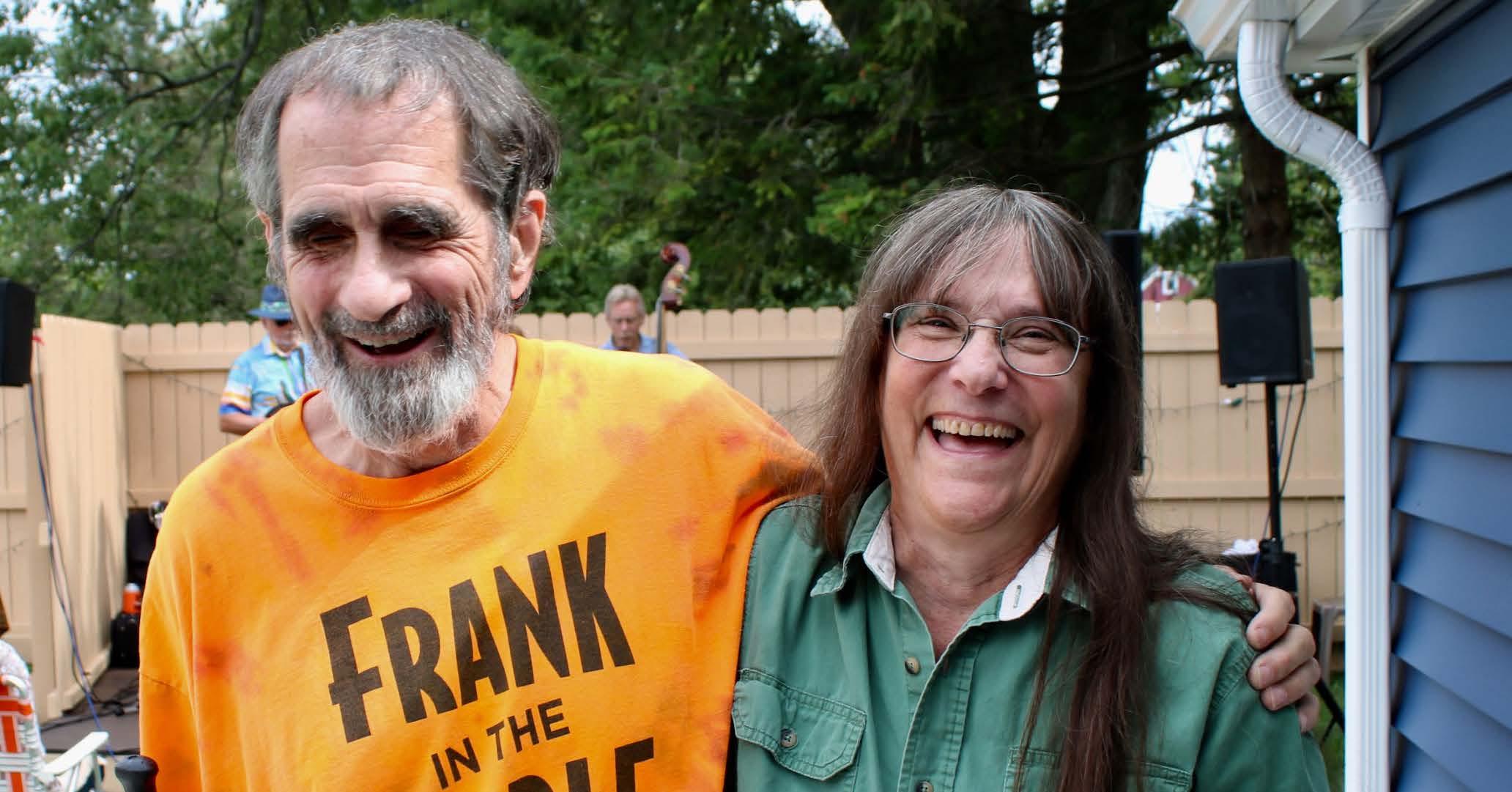
Graduating from Colgate University and filling in for a year of teaching English at Canandaigua Academy in 1974, Meyer was successful enough in the classroom that he kept getting a next year’s assignment and was approved for tenure after his third year.
He was also devoted to playing guitar and writing songs. Meyer had first performed in public at The Agora, a Colgate campus coffeehouse.
On the night of that debut, “I drank nearly a six-pack of beer to calm my nerves,” he said. “Despite all of that beer, it was a show I will never forget. For the first time in my life, I felt that I was in a place where I was supposed to be. That night I learned that, for me, nothing tops being able to use music to open the hearts and souls of people.”
With a day job at Canandaigua Academy, Meyer ventured further afield and starting getting singing gigs in restaurants and pubs. When a local band, Mulligan Stew, broke up, Meyer joined with former singer Steve Miller to form Meyer and Miller. They were joined by singer Carol Mulligan and became Meyer, Miller and Mulligan.
Enter McGuire.
“I was an administrative assistant at a subsidiary of the phone company,” she explained.
She worked for Miller. So, when the band was playing, she’d come listen. On a night at George Cullen’s pub, Meyer was introduced to McGuire.
And it was electric.
“I brushed against her elbow… and I felt an instant attraction to her,” he said.
That gentle touch meant a lot more to him than most people. Meyer is totally blind.
But it wasn’t meant to be. Yet. Later than night, she told him she was taken.
Meyer was disappointed, but the tingle from that gentle touch lingered.
The two kept bumping into one another because they knew the same musicians. In 1981, He became a solo performer and she started showing up to listen to his songs. They moved in together in 1982 and she became Frank’s roadie.
“She was running the sound for my gigs,” he said. “In the early 1990s, she learned to play bass guitar.”
Their relationship grew into a personal, academic and musical partnership. She had joined him in the classroom as a teacher’s aide in 1990.
“I read the mail, graded tests, passed out papers, did the copying, the typical things,” she said.
“She would read student essays to me,” he said. “The 16 years before I met her, I would hire people to read to me. I also had some volunteers and colleagues who had free periods who would proctor my tests.”
In the weekdays, they would take care of the business of academics. At nights and on weekends, it was music.
They practiced, honed skills, recorded songs and played a schedule that just kept growing. Meyer’s songs are personal and reflective. From their title song from their "Road Less Traveled" CD:

“There are many roads to travel, many things to be,
It seems the road less traveled has worked the best for me…
So I sat down, let my words flow,
And just like little children, watched them grow.
And as I guided them with my heart and hands,
They began to spread their joy throughout the land."
“Frank is attractive, he has a great sense of humor and he’s practical in a life sense,” she said. “He doesn’t get worked up over things that aren’t worth getting worked up about when there’s nothing you can really do. Life has bad things happen; you deal with it, but you don’t let it ruin your life.”
“Siobhan has an infectious laugh,” he smiled. “Anywhere people are laughing, you know it’s her. She’s a sensitive person: what she does for me, she’s more understanding of people’s situations and gives me perspectives. She lights me up. She says, ‘Let’s try this, let’s do this.’ She gets me to balance.”
The duo has three albums available: "The Road Less Traveled" and "Caught in the Middle", and Frank has one solo CD, "Hometown."
Their latest CD, Still Giving It Our Best, debuted at a concert at Brew and Brats in Naples in September. Wellknown local Americana musicians Perry Cleaveland and Maria Gillard are part of the new album and the concert was also a celebration of the 40 years they’ve been together.
Meyer and McGuire do some of their recordings in a closet in the basement of their home. She handles the technical side, doing all the mixing and recording and balancing.
“She’s the whole tech side of the production,” he said proudly.
With his mastery of the internet, he puts up special song lists on Spotify, interspersing Meyer and McGuire songs with those of the Beach Boys, Jerry Garcia and a lot of other artists, providing an hour’s worth of listening for each album and there are many.
With all the recording, performing (24 shows a year) and songwriting going on with Meyer and McGuire, they also found themselves stepping up to promote local songwriters.
“In 2012 we were playing at the now-closed Buffalo Bill’s in Shortsville,” he said. “The owners, Bill and Robin, had a side room off their bar. They said, ‘We’ve got to do something with the side room.’”
Meyer told them, “If we’re going to do something, I want to do something creative, not just open it up to regular bar gigs. Let’s move in the direction to get songwriters to present their work.”
“In 2012, songwriter Maria Gillard, a friend for 40 years, began the series
and from then to 2018 we did shows there every other Thursday night for songwriters throughout the area,” he said. “But then Bill and Robin retired, and the buyer closed the restaurant for renovations.”
Rafael Guerrera, who owned Rio Tamatlan’s Mexican cuisine restaurant in Canandaigua, suggested to Meyer and McGuire, “Why don’t you bring that songwriter thing over here?”
“He had a room upstairs where we could continue with songwriters,” Meyer said. “We started up again until March 16, 2020, when the bottom fell out with the pandemic.”
A year later, as the pandemic started to lift in the area, Meyer and McGuire had a new idea.
They found the perfect site — their own back yard, complete with swimming pool.
“A friend built a (performance) deck for us and we rearranged the yard a little bit,” he said. “We did four shows as the Parkside Poets in 2021 and again Maria Gillard started the series. We did six shows this summer.
“It’s a comfortable level for our audience. For our social demographic, most people are 50-plus and it’s a nice comfortable setting for them. We started getting some neighbors coming over. We like it. We’ll keep doing this as long as we can.”
Meyer averages 20-40 people for each performance, all comfortable in the chairs they brought with them, enjoying the drink and snacks they walked in with. “We have not yet gotten to the point where people have to make a reservation,” he said. “We can hold up to 50 people and if it gets to be a problem, we’ll address it. It’ll
work out over time.”
The musicians who take the stage “really enjoy it and want to come back,” Meyer said. “(WRUR deejay and songwriter) Scott Regan loves coming here. He’s been a consistent performer for us since 2012; such a great guy and a really good songwriter. Our goal — I want to present the songwriters with a nice venue, a spot to play and I’ll do my best to get them a good audience. People keep saying ‘Yes.’”
On July 31, the Cadleys (John and Cathy Cadley on guitars and vocals, John Dancks on bass and Perry Cleaveland playing mandolin and fiddle) took the stage in front of a couple dozen people. In that tiny venue, nobody missed the role the audience played.

“It’s so valuing an effect,” said Cleaveland. “We appreciate the people being in the audience, but we can actually feel how palpable it is because of their proximity to us in this venue. Frank and Siobhan have created the perfect size for it. I’ve been to festivals, for example, where things are so spread out there’s no connection with the people. Because that’s why we do it: we want to connect with people. When you have something like this, where you can see the people in the audience and their expressions and feel them with you, that really spurs on a reciprocal relationship we have with the audience and it spurs more creativity and musicianship.”
He said the Meyer and McGuire Parkside Poets site is about the most intimate he’s played in.
“The square footage and the way it’s laid out — people have a tendency, the old church tendency, to sit in the
pews in the back of the church. But not here. When you’re more constrained with what you have to work with, in a nice way, you want to be closer together. I think that works well for this audience and the performers,” he said.
Cleaveland has played with many band combinations, “but Meyer and McGuire is probably my favorite band to play with because it’s so easy and relaxed. Their attitudes, they’re all about the fun: they get that relationship. A lot of bands get kind of caught up in trying to be perfect. This isn’t perfect. It’s more about the fun we’re having,” he said.
John Cadley said Meyer and McGuire have succeeded in what they attempted to do.
“This is great,” he said, gesturing with open arms about the backyard layout. “People come specifically to hear the music. It’s not like a bar where they come to talk and drink and music just happens to be there to listen if they want to. They come specifically to hear the music. They come here to listen to the original songs and they really do listen. For a songwriter that’s the best you can hope for, to feel that you’re really connecting with the audience and they get what you’re saying.”
On the concert afternoons, McGuire plays hostess and Meyer is the emcee, both visibly enjoying their roles.
And the music unfolds. Nobody seems to enjoy the afternoon as much as McGuire and Meyer.
And all this came about by the touch of an elbow.




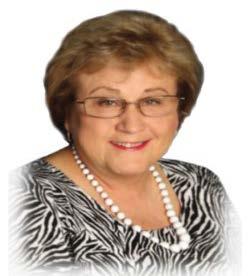



Powerful change often comes from a place of personal heartbreak.
Such is the case for Debra Kostiw of Henrietta, author of “Forget Me Not: The #1 Alzheimer's and Dementia Guide for Professional and Family Caregivers” (October 2022, Amazon.com).

More than a decade ago, her mother, Ellie McGarigle, was beginning to need more and more help with activities of daily living as the effects of dementia were becoming evident.
Kostiw was unable to dedicate the time as a full-time caregiver. It seemed like a good solution when a family caregiver arranged to take her into his home. McGarigle moved in with the family member who lived hundreds of miles away. Kostiw alleges that afterwards her mother was coerced into signing away her legal rights and her financial resources to her caregiver and despite this she suffered neglect and abuse. Kostiw believes that McGarigle died because of this family member’s negligence —a tragedy she feels determined that no other family should experience.
Kostiw was the catalyst behind senior caregiver legislation currently on the floor of the NYS Senate.
Introduced by state Senator Samra Brouk, the bill prevents caregivers from inheriting money if they have been convicted of elder abuse.
Kostiw also wants to equip more people with the knowledge and strategies they need to provide memory care, whether as a family caregiver or as part of their work. “Forget Me Not” uses case studies and recent research in dementia care in an easy-to-read volume.

Sharon Brangman, chief of geriatrics at SUNY Upstate Medical University in Syracuse, wrote the
forward to the book.
“When I’m working with patients, I emphasize that there’s not a pill that fixes all the problems we see,”
Brangman said. “A lot are nonpharmacological approaches. It’s about getting caregivers to understand what might be happening in the person’s brain and the right way to approach it. Most caregivers are frustrated because their loved one is agitated.”
She added that this behavior does not indicate poor caregiving, but it is simply how the disease manifests.
Brangman likes the straightforward language and practical tips “Forget Me Not” offers.
“We often can’t answer all their questions in the office visit,” she said of caregivers. “It’s good to have a reference to use. “This book really covers the most common problems we see in our patients and it breaks it down into sections where you can
understand what is going on and the best way to approach it.”
She recommends “Forget Me Not” for family caregivers and relatives of dementia patients, but also for professionals such as nurses, physicians and nursing home staff, as little training in nursing or medical school focuses on working with patients with dementia.
“Debra’s a great resource and I know writing these kinds of books is very time consuming,” Brangman said. “We’re fortunate she took the time to organize and get down this information.”
Kostiw sees the need for “Forget Me Not” at the business her husband, Paul, owns, No Place Like Home Senior Care in Henrietta. She noticed through the recruiting process that candidates who said they had worked in memory care had only completed a one-hour class. Their approach to
care stemmed from a perspective of doling out sedating medication and wrangling patients with difficult behavior. Instead of these, “Forget Me Not” focuses on strategies for preventing and mitigating potential conflict.
Kostiw believes that for many people caring for patients with memory issues “they go to work every day thinking they’ll be fighting with patients, it will be horrible and there will be resistance and arguments. It’s stressful,” Kostiw said. “That’s because they don’t have the proper skills and training to know how to handle situations or turn a bad situation around. The more I’d hear from aides and nurses and everyone I talked with in the medical community, they said they don’t have the training to help families and patients at the level they want to.”
She decided to provide that information in “Forget Me Not” as a relatable volume of practical information.
“I decided I needed to put all my knowledge and experiences, personal and professional, together in one cohesive resource for the professional, the doctors, nurses and memory care unit workers, those working in the dining room in assisted living. It’s also for financial planners, bank tellers, restaurant workers — anyone who comes across people with dementia. It’s also for family caregivers, the daughter, the grandchildren, if you have friends at church showing signs of memory issues. It’s a resource that will help anyone working with someone.”





Although medication may slow the progression of dementia, no treatment exists for it. The only approach is early diagnosis to offer the patient and family the opportunity to choose how they want to live, such as aging in place, assisted living and nursing home care. The family and other caregivers can learn coping strategies for making life easier for the patient.
Kostiw is a certified dementia practitioner and hosts a radio show on WYSL about dementia. She also operates a YouTube channel, Answers About Alzheimer’s.

By the end of the year, she hopes to launch an online program with different levels of training people can take and a certification program for professionals or family caregivers.

Magic. Surprise. Delight. Extraordinary ideas and innovations. Reflection. Accomplishment.
In its history and presence, Geva Theatre in Rochester has dealt in all these things.
Now in its 50th season, Geva lays out the gifts new artistic director Elizabeth Williamson has brought with her. Expect to be moved and awed. Expect to leave the theater singing on some nights. Expect to be left with so much to think about. Expect to remember a scene and laugh to yourself.
Williamson, 43, brings an elaborate and definitive pedigree with her. Raised in a family of two generations of poets and academics, the muses hung lightly in her home. She started with puppet shows using her stuffed animals behind the back of the couch.
She was 7.
Did she do the directing?
“Of course,” she said with a big proud smile. “When I was 12, I started writing and directing my friends in little shows every summer. The most successful one was about Joan of Arc. I was not Joan. I thought I wanted to be an actor but what I was actually doing was writing and directing. I made my best friend play Joan of Arc and she had no interest in acting. She turned out to be a real political activist later in life. I think I saw that streak of determination and idealism in her and I said, ‘You’re Joan of Arc.’ I’ll play the supporting roles.”
She wrote a play, “probably 10 pages long.”
“It had the dauphin and the voices of the saints who came and spoke to Joan and her rallying the troops and everything. It was me and my best friend and her little sister. And, three
Elizabeth Williamson has brought broad expertise in dramaturging — adapting, developing, producing and directing stage performances in England, France and across America. She took over earlier this year as the first woman artistic director at Geva Theatre
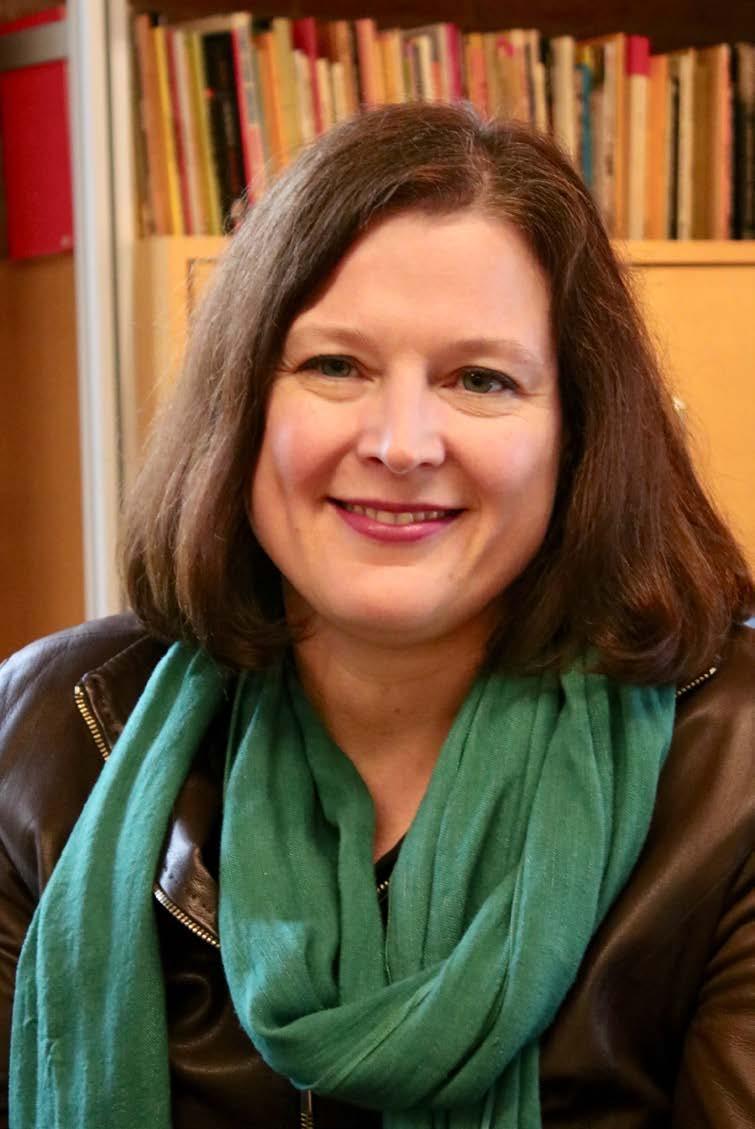
of our other friends that we sort of dragooned into doing it,” she added.
College at Bennington in Vermont. Grad school at Oxford University. She was following the track her family had. Then, got off the rails. Way off.
“I was pretty radical,” she admitted. Her parents and grandparents were English lit experts: she went rogue with deep studies in French literature at Oxford.
She loved the research, but didn’t want to do scholarly articles.
“I wanted to turn what I learned into pieces of theater. I loved digging into novels and all sorts of research and turning that into (theater) art,” Williamson explained.
She did theatrical training at Ecole Internationale de Theatre Jacque Lecoq in Paris.
“There’s an extraordinary theater company that’s based out of London called Complicite. They made a number of extraordinary shows, a lot that came to America through the Lincoln Center Festival. I was really blown away by their work when I was in my 20s and I trained with them a bit. It turns out they had all trained at Ecole Jacques Lecoq. So, that’s where I wanted to go,” she explained.
She learned how to create stage pictures, how to work with actors, how to move people on stage, how to amplify the words in a play visually.
Williamson was one of the youngest people (22) to get accepted to the Lincoln Center Theater Directors Lab in New York.
“The focus the year I went was how to direct style and how to direct contemporary style,” she said. “Of the 100 or so directors who were accepted in that summer’s program, about a dozen of us were also accepted to direct workshops of contemporary plays in different styles. I had chosen Sarah Kane’s play for 4:48 Psychosis. I had the opportunity directing a workshop figuring out how I would create the world of that play.”
And what a play — an intense choice. One critic described it as a “suicide note.”
Indeed, Kane committed suicide shortly after writing it.
Williamson directed productions at the New York International Fringe Festival in 2001 and the following summer, was directing productions at the HERE performing Arts Center.
“I did a number of early-career director things that young directors do if they’re lucky,” she said.
The training at Ecole Jacque Lecoq helped her straighten out her career path.
“I realized I wanted to train by watching other directors at work. So, I started to do a fair amount of associate and assistant directing. And I worked with a lot of extraordinary directors who direct shows that move extremely well and have very strong visuals and
visual metaphors,” she said.
She worked with Dominique Serrand at the Theatre de la Jeune Lune he founded in Minneapolis. At Steppenwold Theatre in Chicago she was the dramaturg for Mary Zimmerman’s production of Monsieur Proust. She assisted JoAnne Akalaitis at the Court Theatre in Chicago.
What’s a dramaturg? It’s someone who researches, adapts, produces and directs productions.
At 29, Williamson was named the associate artistic director for Pioneer Theatre Company in Salt Lake City.
“Pioneer Theatre is like the Geva of Salt Lake City,” she said. “I founded and led their new-play program, commissioning and developing new works. I was there for four seasons.”
While at Pioneer, Williamson launched the career of playwright Bess Wohl, who was nominated for a Tony Award for her first Broadway production, Grand Horizons.
“I gave her her first professional production as a playwright,” Williamson said.
Next was an eight-year stint at the Hartford Stage in Connecticut. Willamson’s role was all-encompassing.
“I led their new work, new play development as associate artistic director. I produced the season, also directed, translated and adapted work for the stage there,” she said. “That was my home for eight years.”
She dramaturged a number of productions in Hartford and here is where the threads lead to Geva’s fabric for the 2022-23 season.
With her French literature background, Williamson translated Marivaux’s play, "La Dispute." She also commissioned and developed Matthew Lopez’s play, "The Inheritance", for the Hartford stage. It later won the Olivier Award in London and was nominated for a Tony on Broadway.
Two other plays Williamson dramaturged in Hartford made it to Broadway — Robert L. Freedman’s "A Gentleman’s Guide to Love and Murder" (won four Tonys including best musical) and "Anastasia", which ran for two years on Broadway.
Williamson got increasingly busy doing freelance work and left Hartford to expand that part of her career.
“I was about to move to New York and then something happened,” she explained.
Covid hit. Theaters went dark.
She went back to the family home in Carmel, California.
“All the freelance work I was doing could have been done anywhere, so why not Carmel, where I could walk to the beach, rather than be in an apartment in New York City and being afraid to leave?” she said.
Time passed and in 2021, a search firm called her. Geva was looking for an artistic director.
“I knew about Geva and its commitment to new work and since new work has been the heart of what I’ve done, that was very appealing to me. And as I started to hear more about Rochester, I just fell in love with the city. It’s such a wonderful place,” she said.
“If I could count the number of people who said to me, ‘Well, we moved here 40 years ago and we thought we’d be here just a year or two. And then we never wanted to leave…’ And let me tell you — that’s not something you hear about many cities. It’s really a special place, Rochester,” she added.
“The history of all the extraordinary ideas and innovations that have come out of Rochester. Extraordinary thinkers who have lived here. The history of really caring about art and our cultural organizations have led to this extraordinary richness of art culture organizations here, which per capita must be higher than any other city of our size when you look at the museums, symphony, Garth Fagan, the Eastman School, Onondagan — just extraordinary cultural institutions here. They make it a really vibrant and exciting place to live,” she said.
Hired at the beginning of the year, she reached back into experience and spread it to Rochester and developed her first season of shows here.
“Geva will be programming a mix of reimagined classics and musicals and new work; all created by some of the most exciting artists working in the field today,” she promised.
"Jane Eyre" was the initial offering for the 2022-23 season, bringing something Williamson had birthed in Hartford to Rochester.
Next was "Somewhere", a Matthew Lopez play which has Williamson working with that playwright again.
Then came the Geva version of "A Christmas Carol", directed by Mark Cuddy, with Michael Preston as Scrooge because Guy Paul, a familiar
actor to Rochester audiences, was taking a hiatus on the role. The play has been described as a “sparkling classic.”
"Ain’t Misbehavin’: The Fats Waller Musical Show" debuts Jan. 17 and it is going to be special.
“We are co-producing this with the Barrington (Massachusetts) stage,” Williamson said. “When the New York Times saw it they made it a critic’s pick and said, ‘This is how you do a revival.’
“Jeffrey Page, Beyonce’s choreographer and owner of an MTV award, is directing and choreographing. This is a new vision of the show that’s still true to what’s extraordinary about the material while casting a fresh light. It’s a real coup to have Jeffrey here. There’s more dance in this than you would normally expect in a production of 'Ain’t Misbehavin’,” she said.
More music fills the more intimate Fielding Stage at Geva for Woody Sez: The Life and Music of "Woodie Guthrie", which runs Feb. 1-19 and features a hootenanny, involving cast members and anyone else who wants to join in, after the Sunday shows. Williamson thinks those Sundays will be fun.
“You get a wonderful intimate feel in that musical,” she said.
Williamson is the first female artistic director at Geva and she landed another coup — the production of Sarah Gancher’s play "Russian Troll Farm: A Workplace Comedy." It “will mark Geva’s first partnership with a Broadway producer,” Williamson said. “We’re working with director Dori Berinstein and this is the first time Geva has done a pre-Broadway production.”
As she was programming her first season at Geva, Williamson called Berinstein and asked, “Hey, Dori, why don’t we start "Russian Troll Farm" here?”
“I think it’s really an exciting thing for an audience to know they’re seeing something before the rest of the world,” Williamson said, adding that Berinstein is involved in every stage of the play’s development. “Some people will act in it here and follow it to Broadway, that is the goal.”
The show runs Feb. 28 to March 26.
Then Geva welcomes DeLanna Studi, a Cherokee actor, in "And So We Walked: An Artist’s Journey Along The Trail of Tears", a one-woman show.
DeLanna is the daughter of movie actor Wes Studi, who starred in "Last of the Mohicans" and made a film himself about The Trail of Tears. He was also the voice of Eytukan in the film "Avatar." DeLanna will hold the stage in her hand from April 4 – 23.
On May 9, Geva opens Rodgers and Hammerstein’s "Cinderella." “It’s a beautiful new production inspired by French fairy tale books from the 19th century, those pop-up books where things come alive,” Williamson said. “I think that will be just magical. The world pops up off the page when you read them.” Shelly Butler will direct.
Geva closes Williamson’s first season with "We Are Continuous" from March 22 to April 9; written by Geva’s playwright in residence, Harrison David Rivers.
In 1972, William Selden and Cynthia Mason Selden founded Geva in space at the Rochester Business Institute on South Clinton Avenue. Ten years later, Geva bought space on Woodbury Avenue and renovation began. A $4.2 million major gift campaign in 1997 led to the purchase of the building and construction. An $11 million renovation followed in 2016 and 14 studio apartments were built for visiting artists.

Geva has a $7 million annual budget, employs 200 people in season and impacts the local economy by at least $10 million. It is supported by 10,000 ticket-holders. Many noted actors, directors, musical directors, designers and stage managers have crossed the stages and 16,000 school kids visit every year.
Now the theater is in the hands of Williamson, who also serves as co-CEO with Chris Manelli.
“It just feels like a wonderful match,” Williamson said. “As soon as I started talking to the board of trustees here, it felt like we had shared interested and goals. They want Geva to be taking its work to a more national and international stage. Some of the artists we have here are eminent in their fields in New York and London. It’ll be really thrilling to get them here to Rochester and have them making work for a Rochester audience and then we’ll be taking that work out into the world.”
This is the time of year when those of us who live in the 315 area code start thinking about mice, like the ones who are trying to spend the winter in your house.
But I have a story to share about a certain mouse that became a friend and gave me a lovely experience. And the story is all true.
Many years ago, I made a living as a corporate trainer, teaching good-writing habits to business and technical professionals. My clients — many of them multi-national companies — normally made my lodging arrangements for me. My classes usually took three days to a week.
One fine day I found myself in a brand new hotel in Baton Rouge, Louisiana. I was watching TV, trying to doze off after dinner. It had been a long day of classwork. I was about two-thirds asleep when I realized something was in bed with me; on top of my blanket — looking at me.
I opened one eye, cleared my vision and stared at a mouse that was perched, more or less, on the comforter above my big toe. This was a little hard to believe. The hotel was pretty swanky, but brand spanking new. This guy must have found a hiding place during construction.
He wasn’t hiding anymore. He was staring at me, bemused.
I slid my hand over to the nightstand and picked up the phone. I pushed the button for the hotel operator. The mouse watched me, interested.
“Hotel operator,” someone with
a pleasant voice answered.
“I have a small problem,” I told her quietly, keeping my movements as still as I could.
“Yes, sir?”
“I have a mouse in my room.”
“Are you sure?”
“Am I sure it’s a mouse or am I sure it’s in my room?”
She paused. She’d already deduced by my voice that I was a Yankee. “Are you sure it’s a mouse and is it in your room?”
“Yes and yes.”
“Would you like me to call the bellman for you?”
“I don’t think the mouse has any bags to carry.”
“Would you like me to call the exterminator for you?”
“How long do you think that would take?” I asked.
Another pause. This was a new hotel and nothing in the operator’s “How to Be a Good Hotel Operator” training covered this. And, I was a Yankee on top of it.
“To tell you the truth, sir, I think our exterminator is just for bugs and things, you know?”
“Not ready for big game, you’re saying?”
“I don’t know what he’d do for a mouse except set a trap or something.”
The mouse hadn’t moved off my toe. “I don’t think this mouse is the kind who will go for a trap,” I told the operator. “He’s a pretty bold little guy.”
“Where do you see the mouse, sir?”

“I’m looking at him right now.”
“Is he under the bed?”
“No, he’s on the bed.”
“And where are you, sir?”
“I’m on the bed, sort of under the mouse.” I thought she’d enjoy pondering that for a moment.
“Sir, I’m going to connect you with the manager.”
I hear a couple of clicks and then a buzz on the phone. I assume the operator is reporting to the manager and the manager is figuring out what to do. I check on the mouse, and he’s munching on a piece of Oreo cookie I must have dropped on the floor. I’m wide awake now.
“Mr. Addyman, this is Mr. Smith, the assistant manager. Do I understand that you have an infestation problem of some sort?”
Managers of this fine chain of hotels are trained not to use the M-word, I gathered.
“Yes, Mr. Smith, I have a vector on my comforter.”
“Are you in bed, sir?”
“I am.”
“Are you comfortable?”
“I am, sir. This is a lovely room.”
“What behavior is the infestation exhibiting?” he asked. This guy was magna cum laude at some hospitality school.
“My little friend — let’s call him Mickey — is eating what’s left of an Oreo cookie.”
“Does he seem hostile, Mr. Addyman?”
“No, he’s pretty laid back, Mr. Smith. I think he likes your hotel
and plans to make it his home. He apparently likes your guests, too.”
I think Mr. Smith sat down. The silence at the other end of the phone told me Mr. Smith was having agita. But he rallied.
“Mr. Addyman, let me assure you we take every precaution to remove and prohibit pest infestation of any sort.”
“Well, you missed one,” I told him. And now I was getting a little fed up. I figured Mr. Smith was employing a tactic from hotel school to keep me on the phone long enough for the problem to solve itself.
My mouse was getting bored, too. He jumped off the bed and headed for the heating–air conditioner unit, where he lived, I gathered.
Then he changed direction.
“Uh-oh, Mr. Smith,” I said as I waved good-bye to my companion. “Mickey has bolted; he’s heading for the door and the bottom of that door is high off the carpet and I’m sure he can squeeze under it. Yep! There he goes, Mr. Smith! Off he goes down the hall to visit other guests!”
“Oh, my goodness!” shrieked Mr. Smith.
“Don’t you have a group of Baptist Bible women holding a prayer meeting down the hall, Mr. Smith?”
“Oh, my GOD!!” Mr. Smith was now shouting orders to people. He was, I was sure, rounding up all the busboys and bellhops and front desk staff to run up to the second floor, where I was, to catch the mouse.
I was one step ahead of him.
“Tell you what, Mr. Smith,” I told him. “I’ll run out into the hall and corral ol’ Mickey for you before he gets to the ladies.”
“Oh, thank you, Mr. Addyman!”
“…of course, I’m just getting out of bed. So I’ll be chasing Mickey down the hall in my underwear…”
“Oh, NO, Mr. Addyman!”
“…at least I THINK I have my underwear on. It’s so hot down here and the room is so warm…”
“Mr. Addyman, please stay in your room. PLEASE! I’m sending people upstairs right now to catch the mouse.”

Wait a minute…what did he say? What were his people going to catch? Did he use the M-word to a guest? There was silence now on the phone. He was hoping I didn’t notice him using that word.
I could hear people in the hall now. Somebody — this I couldn’t believe — had his fingers under my door, feeling for the mouse.
Stepping over to the door quickly, I gently pinched one of his fingers.
“YIKE!” came the sound from the other side of the door.
In a second, Mr. Smith was knocking on my door.
“Mr. Addyman, you must open the door so we can catch the, uh…so we can have a talk with Mickey.”
“Just a second.” I quickly put on my tie, stepped into my pants and shoes and opened the door. For the next five minutes, six people looked high and low in my room for Mickey. They found nothing. Mr. Smith was the last one to leave, apologizing profusely. He offered me the rest of my stay on the concierge floor. I accepted.
The bellhops returned and took my stuff to a much nicer room. I lingered one last minute after everyone had left.
I took a cookie out of the bag in my briefcase and put it under the heating–air conditioning unit.
“Thanks, Mickey,” I said. I thoroughly enjoyed the rest of my stay at that hotel.
Retired Farmington town supervisor describes himself as 'a retired person who is living the dream'

Q: Of your many career achievements, which has been the most fulfilling?
A: Several that come to mind — I’m proud of my 22 years in the Air Force and the two tours of duty (about 10 years) with the US Air Force Recruiting Service. We faced some big challenges during the Vietnam War with all the protesting and antiwar sentiment. I remember one protester standing with his sign outside the Armed Forces Examining and Entrance Station. I felt sorry for him, alone in the cold. I invited him in to warm up with a hot cup of coffee. I think he appreciated it because from that point on he always greeted me with a friendly ‘Hi Sarge.’ I later found out he was a veteran with some medical issues.
Then years later, on my first day as Farmington town supervisor I thought to myself, ‘OK, now what should I do?’ My secretary came in with the morning mail and we reviewed the correspondence as she made some suggestions. I started the process of routing the mail with notes on actions. That secretary who guided me on the
office routines is the elected town clerk today.
By the time I left office, the town’s general fund had no debt and we had approximately $5 million in the bank. We were able to pay cash for capital projects other towns might normally have to finance, like a highway garage that will last for decades, a state-of-theart town court facility, an upgraded wastewater treatment plant that serves Farmington, Victor and parts of Canandaigua, and an expanded salt barn that provides ample enough local storage to carry us through the most difficult winter.
Q: How has your own life changed since retiring?
A: “The pace in which I go through the daily routines has slowed down. I still have appointments and we are lucky to have our children and grandchildren in the area so we can watch the grandkids grow up. In retirement we thought it was too quiet at times so we adopted a cat from a
local cat rescue organization and she has taken a prominent place in our home and our hearts.
Q: What was one unexpected retirement challenge you encountered, and how are you dealing with it?
A: When you are a town supervisor, you’re used to working 10 to 12 hour days with meetings, dinner events, training sessions and roughly 20 to 40 incoming or outgoing phone calls a day. When you retire, all of a sudden that stops. I didn’t realize that and knew I had to find a way to transition somehow.
Before I became a town supervisor, I taught at community colleges, so I applied for an adjunct faculty job at Finger Lakes Community College teaching in the business department. The lesson plan preparation, composing quizzes and examinations, arranging for a guest speaker now and then and, of course, teaching twice a week kept me busy. It was a great transition for me, and I enjoyed it.
I also did some training sessions for area county governments and notfor-profits off and on for several years. And I sit on the board of a veterans’ organization and serve on the board of ethics for a local government.
Q: What advice would you give to others entering and looking to thrive in retirement?
A: Have a plan ready for after you’ve rested for a while. How are you going to adjust? All the things that were part of your daily life are not there, so what are you going to do with all that energy? Slowing down can be very difficult.
Q: What’s one core value that has served you well through your career and into retirement?
A: Never stop learning. Continue to improve your knowledge base and don’t be afraid to explore an unfamiliar subject or course or discussion.
Also, my dear wife, Rosalie (Rosemary), has been at my side helping, coaching me, advising me and, yes, even prodding me throughout ‘our’ career. She was my campaign manager when I first ran for town supervisor and was elected. I remember when I was in part-time grad school while working full-time she would always make sure I was ready for class.

